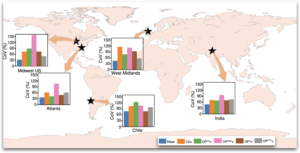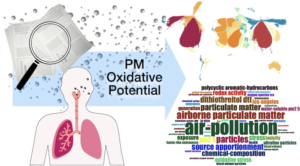2024
Salana, Sudheer; Yu, Haoran; Dai, Zhuying; Ganesh-Subramanian, P. S.; Puthussery, Joseph V.; Wang, Yixiang; Singh, Ajit; Pope, Francis D.; Leiva, Manuel A.; Rastogi, Neeraj; Nand-Tripathi, Sachchida; Weber, Rodney J.; Verma, Vishal
Inter-continental Variability in the Relationship of Oxidative Potential and Cytotoxicity with PM2.5 Mass Journal Article Forthcoming
In: Nature Communications, Forthcoming, ISBN: 2041-1723.
Abstract | Links | BibTeX | Dimensions | Tags: 2024, concentration-response functions, Cytotoxicity, epidemiological models, Oxidative potential
@article{nokey,
title = {Inter-continental Variability in the Relationship of Oxidative Potential and Cytotoxicity with PM2.5 Mass},
author = { Sudheer Salana and Haoran Yu and Zhuying Dai and P.S. Ganesh-Subramanian and Joseph V. Puthussery and Yixiang Wang and Ajit Singh and Francis D. Pope and Manuel A. Leiva and Neeraj Rastogi and Sachchida Nand-Tripathi and Rodney J. Weber and Vishal Verma},
url = {https://www.nature.com/articles/s41467-024-49649-4},
doi = {10.1038/s41467-024-49649-4},
isbn = {2041-1723},
year = {2024},
date = {2024-06-12},
urldate = {2024-06-12},
journal = {Nature Communications},
abstract = {Most fine ambient particulate matter (PM2.5)-based epidemiological models use globalized concentration-response (CR) functions assuming that the toxicity of PM2.5 is solely mass-dependent without considering its chemical composition. Although oxidative potential (OP) has emerged as an alternate metric of PM2.5 toxicity, the association between PM2.5 mass and OP on a large spatial extent has not been investigated. In this study, we evaluate this relationship using 385 PM2.5 samples collected from 14 different sites across 4 different continents and using 5 different OP (and cytotoxicity) endpoints. Our results show that the relationship between PM2.5 mass vs. OP (and cytotoxicity) is largely non-linear due to significant differences in the intrinsic toxicity, resulting from a spatially heterogeneous chemical composition of PM2.5. These results emphasize the need to develop localized CR functions incorporating other measures of PM2.5 properties (e.g., OP) to better predict the PM2.5-attributed health burdens.},
keywords = {2024, concentration-response functions, Cytotoxicity, epidemiological models, Oxidative potential},
pubstate = {forthcoming},
tppubtype = {article}
}
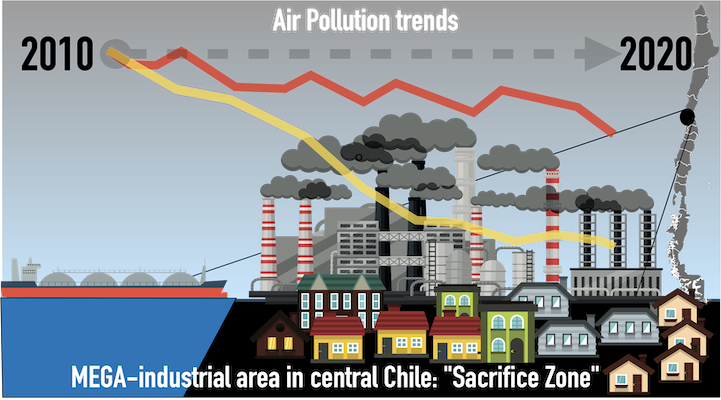
Claramunt, Tomas; González, Fiorella; Ávila, Sebastián; Leiva, Manuel A.; Toro, Richard
Long-term assessment and acute air pollution events in a mega-industrial area in central Chile Journal Article
In: Urban Climate, vol. 55, pp. 101880, 2024.
Abstract | Links | BibTeX | Dimensions | Tags: 2024, air pollution assessment, air quality standards, airborne particles, Chile, control strategy
@article{nokey,
title = {Long-term assessment and acute air pollution events in a mega-industrial area in central Chile},
author = {Tomas Claramunt and Fiorella González and Sebastián Ávila and Manuel A. Leiva and Richard Toro},
doi = {10.1016/j.uclim.2024.101880},
year = {2024},
date = {2024-03-21},
urldate = {2024-03-21},
journal = {Urban Climate},
volume = {55},
pages = {101880},
abstract = {An evaluation of the air quality in the mega-industrial area of Quintero-Puchuncaví is presented through the analysis of the concentration levels of PM10, PM2.5, SO2, CO, O3 and NO2 registered at 10 sites of the official air quality monitoring network in the area between 2010 and 2021. Particulate fractions and sulfur dioxide have been identified as the most critical pollutants. The daily concentration levels of PM2.5 and SO2 registered more than 50 and 300 exceedances per year, respectively, demonstrating the acute nature of the exposure of the population living in the area. The seasonal variability of PM10, PM2.5 and SO2 is characterized by higher concentration levels in the autumn and winter months, especially during the nights and early mornings in low ventilation or calm conditions. The concentration levels of PM10, PM2.5 and SO2 during acute intoxication events does not explain the symptoms of intoxication of patients who have been filling the health care centers in the area since 2011. The concentrations of noncriteria pollutants under conditions of atmospheric stability and low ventilation must be studied in depth to understand the origin of the intoxications, assign responsibilities, and avoid their occurrence in the future.},
keywords = {2024, air pollution assessment, air quality standards, airborne particles, Chile, control strategy},
pubstate = {published},
tppubtype = {article}
}
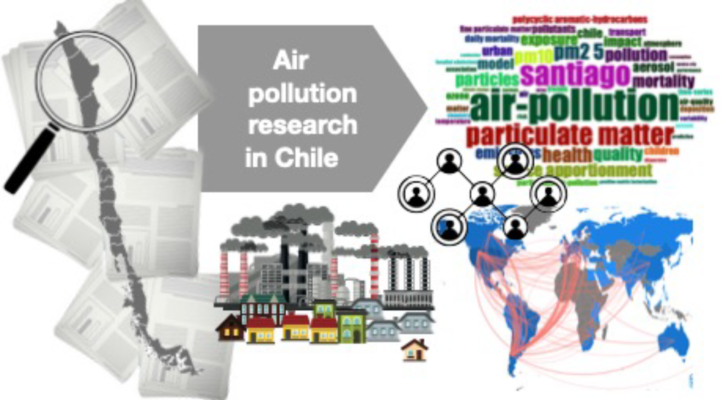
Villacura, Loreto; Sánchez, Luis Felipe; Catalán, Francisco; Toro, Richard; Leiva, Manuel A.
An overview of air pollution research in Chile: Bibliometric analysis and scoping review, challenger and future directions Journal Article
In: Heliyon, vol. 10, no. 3, pp. e25431, 2024, ISSN: 24058440.
Abstract | Links | BibTeX | Dimensions | Tags: 2024, air pollution, bibliometric analysis, Chile, future directions, PRISMA, research trend, scoping review
@article{RN1001,
title = {An overview of air pollution research in Chile: Bibliometric analysis and scoping review, challenger and future directions},
author = {Loreto Villacura and Luis Felipe Sánchez and Francisco Catalán and Richard Toro and Manuel A. Leiva},
url = {https://www.ncbi.nlm.nih.gov/pmc/articles/PMC10847656/ https://www.cell.com/heliyon/fulltext/S2405-8440(24)01462-2?_returnURL=https%3A%2F%2Flinkinghub.elsevier.com%2Fretrieve%2Fpii%2FS2405844024014622%3Fshowall%3Dtrue},
doi = {10.1016/j.heliyon.2024.e25431},
issn = {24058440},
year = {2024},
date = {2024-01-26},
urldate = {2024-01-26},
journal = {Heliyon},
volume = {10},
number = {3},
pages = {e25431},
abstract = {This study provides a comprehensive overview and bibliometric analysis of air pollution research in Chile from 1980 to 2022. The analysis reveals a significant increase in scientific production, a 9.2 annual growth rate, and an H-index of 60. The research spans 33 countries and is influenced by environmental sciences, meteorology, and atmospheric sciences journals. The top ten authors account for 33.49% of all publications, with local institutions contributing more than 35%. The University of Chile and the Pontifical Catholic University of Chile are significant contributors. The most cited articles focus on health impacts and various pollutant sources, emphasizing air pollution as a critical public health concern. The study also emphasizes environmental science, meteorology, and atmospheric science, focusing on topics such as air pollution and health, pollutants, models, sources and chemistry, and social sciences. The findings are affirmed through rigorous discussion and review, providing a roadmap for future research, guiding decision-making processes, and expanding the knowledge frontier in the field.},
keywords = {2024, air pollution, bibliometric analysis, Chile, future directions, PRISMA, research trend, scoping review},
pubstate = {published},
tppubtype = {article}
}
Sánchez, Luis Felipe; Villacura, Loreto; Catalán, Francisco; Toro, Richard; Leiva, Manuel A.
In: Antioxidants, vol. 2024, iss. 13, no. 6, pp. 640, 2024, ISBN: 2076-3921.
Abstract | Links | BibTeX | Dimensions | Tags: 2024, air pollutants, airborne particles, bibliometric analysis, Oxidative potential, PRISMA, scoping review
@article{nokey,
title = {Oxidative Potential of Airborne Particulate Matter Research Trends, Challenges, and Future Perspectives - Insights from a Bibliometric Analysis and Scoping Review},
author = {Luis Felipe Sánchez and Loreto Villacura and Francisco Catalán and Richard Toro and Manuel A. Leiva},
url = {https://www.mdpi.com/2076-3921/13/6/640},
doi = {10.3390/antiox13060640},
isbn = {2076-3921},
year = {2024},
date = {2024-01-22},
urldate = {2024-01-22},
journal = {Antioxidants},
volume = {2024},
number = {6},
issue = {13},
pages = {640},
abstract = {This study is a comprehensive analysis of the oxidative potential (OP) of particulate matter (PM) and its environmental and health impacts. The researchers conducted a bibliometric analysis and scoping review, screening 569 articles and selecting 368 for further analysis. The study found that OP is an emerging field of study, with a notable increase in the number of publications in the 2010s compared to the early 2000s. The research is primarily published in eight journals and is concentrated in a few academic and university-based institutions. The study identified key re-search hotspots for OP-PM, emphasizing the importance of capacity building, interdisciplinary collaboration, understanding emission sources and atmospheric processes, and the impacts of PM and its OP. The study highlighted the need to consider the effects of climate change on OP-PM and the regulatory framework for PM research. The findings of this study will contribute to a better understanding of PM and its consequences, including human exposure and its effects. It will also inform strategies for managing air quality and protecting public health. Overall, this study pro-vides valuable insights into the field of OP-PM research and highlights the need for continued re-search and collaboration to address the environmental and health impacts of PM.},
keywords = {2024, air pollutants, airborne particles, bibliometric analysis, Oxidative potential, PRISMA, scoping review},
pubstate = {published},
tppubtype = {article}
}
2023
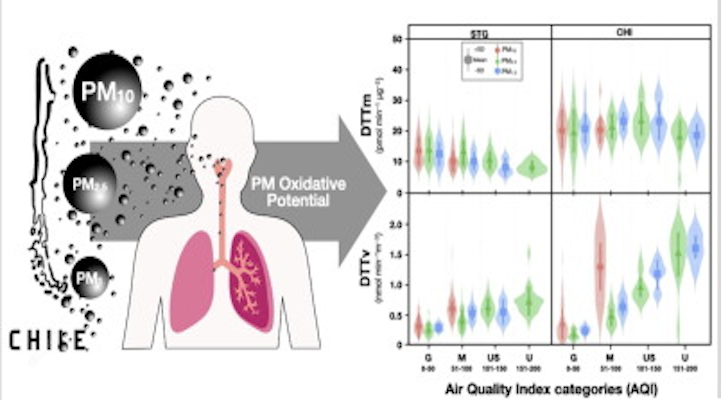
Molina, Carolina; Manzano, Carlos A.; Toro, Richard; Leiva, Manuel A.
The oxidative potential of airborne particulate matter in two urban areas of Chile: More than meets the eye Journal Article
In: Environment International, vol. 173, pp. 107866, 2023, ISSN: 01604120.
Abstract | Links | BibTeX | Dimensions | Tags: 2023, air pollutants, air pollution episodes, dithiothreitol, Oxidative potential, particulate matter, reactive oxygen species, toxicity
@article{RN1,
title = {The oxidative potential of airborne particulate matter in two urban areas of Chile: More than meets the eye},
author = {Carolina Molina and Carlos A. Manzano and Richard Toro and Manuel A. Leiva},
url = {https://linkinghub.elsevier.com/retrieve/pii/S0160412023001393 https://www.sciencedirect.com/science/article/pii/S0160412023001393/pdfft?md5=7cb2a7bdfcaeed38bef0ad9483dc89cf&pid=1-s2.0-S0160412023001393-main.pdf&isDTMRedir=Y
https://www.sciencedirect.com/science/article/pii/S0160412023001393?via%3Dihub},
doi = {10.1016/j.envint.2023.107866},
issn = {01604120},
year = {2023},
date = {2023-01-01},
urldate = {2023-01-01},
journal = {Environment International},
volume = {173},
pages = {107866},
abstract = {Oxidative potential (OP) has gained attention as a parameter that can reveal the ability of different properties of particulate matter (PM) to generate reactive oxygen species (ROS) as one single value. Moreover, OP is also believed to be a predictor of toxicity and hence the health effects of PM. This study evaluated the OP of PM 10, PM2.5,and PM 1.0 samples using dithiothreitol assays in two cities of Chile (Santiago and Chill ́ an). The results showed that the OP was different between cities, PM size fractions, and seasons. Additionally, OP was strongly correlated with certain metals and meteorological variables. Higher mass-normalized OP was observed during cold periods in Chill ́ an and warm periods in Santiago and was associated with PM2.5 and PM1. On the otherhand, volume-normalized OP was higher during winter in both cities and for PM10. Additionally, we compared the OP values to the Air Quality Index (AQI) scale and found cases of days that were classified as having “good” air quality (supposed to be less harmful to health) showing extremely high OP values that were similar to those on days that were classified as “unhealthy”. Based on these results, we suggest using the OP as a complementary measure to the PM mass concentration because it includes important new information related to PM properties and compositions that could help improve current air quality management tools.},
keywords = {2023, air pollutants, air pollution episodes, dithiothreitol, Oxidative potential, particulate matter, reactive oxygen species, toxicity},
pubstate = {published},
tppubtype = {article}
}

Macías-Hernández, Bárbara A.; Tello-Leal, Edgar; S., Oliver Barrios; Leiva, Manuel A.; Toro, Richard
Effect of environmental conditions on the performance of a low-cost atmospheric particulate matter sensor Journal Article
In: Urban Climate, vol. 52, pp. 101753, 2023, ISSN: 2212-0955.
Abstract | Links | BibTeX | Dimensions | Tags: Correction model, Low-cost PM sensor, particulate matter, Urban air quality
@article{NR1002,
title = {Effect of environmental conditions on the performance of a low-cost atmospheric particulate matter sensor},
author = {Bárbara A. Macías-Hernández and Edgar Tello-Leal and Oliver Barrios S. and Manuel A. Leiva and Richard Toro},
url = {https://www.sciencedirect.com/science/article/pii/S2212095523003474},
doi = {10.1016/j.uclim.2023.101753},
issn = {2212-0955},
year = {2023},
date = {2023-01-01},
urldate = {2023-01-01},
journal = {Urban Climate},
volume = {52},
pages = {101753},
abstract = {Continuous measurements of PM10, PM2.5, and PM1 concentrations were carried out by collocating a GRIMM Aerosol Laser Spectrometer model 11-C as a reference instrument and three Plantower PMS7003 low-cost sensor (LCS) from June 11, 2019, to April 23, 2020, in a residential/commercial area of the city of Santiago de Chile. Completeness, precision, linearity, bias, and error metrics were analyzed to evaluate the performance of PMS7003. Linear regression and quadratic polynomial models were proposed to correct the concentrations provided by LCS based on the environmental variables studied. The performance of the LCS was outstanding for the PM1 fraction, obtaining R2 = 0.98},
keywords = {Correction model, Low-cost PM sensor, particulate matter, Urban air quality},
pubstate = {published},
tppubtype = {article}
}
2022
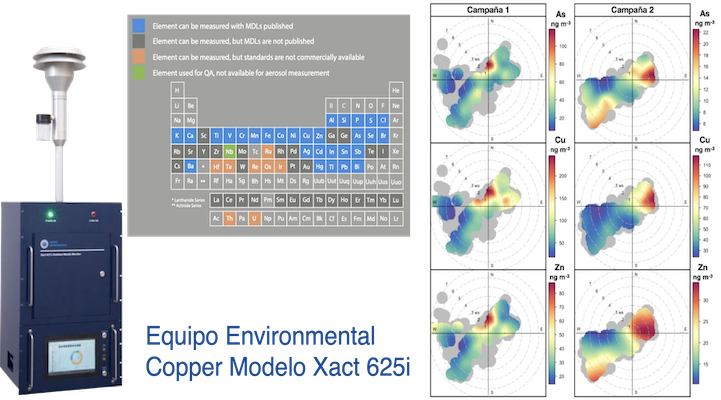
Claramunt, Tomás; García, Andreina; Leiva, Manuel A.; Luis Alberto Navarro,; Sánchez, Luis Felipe; Toro, Richard; Valdés, Ana
Universidad de Chile, Facultad de Ciencias 2022.
Abstract | Links | BibTeX | Tags: air pollution assessment, Arsenic concentration levels, long term trends, Real-time concentrations
@techreport{TR2,
title = {Concentraciones en tiempo real, dinámica atmosférica y contribución de fuentes: Informe de diagnóstico histórico y monitoreo continuo de niveles de concentración de Arsénico atmosférico en la ciudad de Calama (Real-time concentrations, atmospheric dynamics, and source contribution: Historical diagnostic report and continuous monitoring of atmospheric Arsenic concentration levels in the city of Calama)},
author = {Tomás Claramunt and Andreina García and Manuel A. Leiva and Luis Alberto Navarro, and Luis Felipe Sánchez and Richard Toro and Ana Valdés},
url = {http://planesynormas.mma.gob.cl/archivos/2023/proyectos/InformeConsolidado_CALAMA_REV.pdf https://planesynormas.mma.gob.cl/normas/expediente/index.php?tipo=busqueda&id_expediente=937833},
year = {2022},
date = {2022-12-23},
urldate = {2022-12-23},
publisher = {Autoedición Universidad de Chile, Facultad de Ciencias},
institution = {Universidad de Chile, Facultad de Ciencias},
abstract = {El presente informe tiene como objetivo caracterizar los niveles de concentración de metales y metaloides asociados a MP10, en especial de Arsénico (As), en la ciudad de Calama mediante el análisis histórico de las concentraciones de As entre los años 2016-2022 en siete sitios de monitoreo discontinuo ubicados en las inmediaciones de la fundición Chuquicamata y mediciones continuas de metales pesados asociados MP10 y distribución de tamaños de MP en la estación Pedro Vergara Keller (PVK), con el objeto de comprender la dinámica atmosférica de As y generar antecedentes que aporten al proceso de elaboración de la nueva Norma Primaria de Calidad de Aire para Arsénico (NPCAAs). Se realizó una campaña de monitoreo continuo entre el 17 de Agosto y el 13 de Septiembre del año 2022 con el equipo Xact 625i instalado en la estación PVK de la ciudad de Calama, obteniendo un total de 629 mediciones horarias. Además, se realizaron mediciones horarias de la distribución de tamaños del MP y variables meteorológicas para comprender la dinámica atmosférica del As y su relación con otros contaminantes en el área de estudio.
A través del análisis histórico de las concentraciones de As en las inmediaciones de la Fundición Chuquicamata se puede concluir lo siguiente: i) la media anual siempre es mayor a la mediana anual. ii) la diferencia entre la mediana y la media anual se explica a través del análisis de los valores del Límite Superior (Q3-LS), iii) la distribución de los valores del Límite Superior (LS) y los valores anómalos permiten identificar eventos que incrementan las concentraciones anuales. iv) la identificación de los eventos que incrementan las concentraciones anuales permitiría orientar las gestiones tendientes a disminuir el promedio anual de As. El análisis de tendencias históricas de los niveles de concentración media de As empleando el estimador de tendencias TheilSen mostró una disminución estadísticamente significativa de las concentraciones de As para la mayoría de los sitios de muestreo en estudio. Las reducciones de la concentración media de As estadísticamente significativas con un nivel de confianza de al menos el 95% se encuentran en el rango de -7.71 a - 31.6 % año-1 para el período 2016-2021.
Las mediciones continuas realizadas en el año 2022 son consistentes con las mediciones históricas realizadas con mediciones discontinuas en la estación PVK en el período 2016-2021. Adicionalmente, una intercomparación entre 8 mediciones de As discontinuas y los promedios diarios de As calculados a partir de las mediciones horarias del equipo Xact 625i mostró una pendiente de 0.99 y un coeficiente de determinación de 0.89, confirmando la consistencia entre ambas metodologías de medición de As contenido en MP10. El registro de concentraciones horarias aumentó el nivel de dispersión de las mediciones realizadas respecto a los registros históricos con resolución temporal diaria, encontrando eventos agudos de concentración de As que alcanzaron los 493.1 ng m-3.
La media de los tres últimos años históricos analizados (2019-2021) se encuentran por debajo de los tres escenarios normativos de 15 ng m-3, 23.3 ng m-3 y 46.6 ng m-3 en la propuesta de una NPCAAs elaborado por DICTUC y solicitado por el Ministerio de Medio Ambiente (MMA- DICTUC, 2022). Las mediciones obtenidas en el año 2022 difieren del período trianual analizado, cuya la mediana quedó en el límite del valor 23.3 ng m-3 y la media superó este valor sin sobrepasar la concentración de 46.6 ng m-3. Es importante destacar que la comparación de los registros del año 2022 con los diferentes escenarios normativos sólo debe interpretarse en términos referenciales y no corresponde a una evaluación del cumplimiento de los estándares de calidad de aire para As propuestos, ya que los datos obtenidos corresponden al período de medición entre agosto y septiembre de 2022. Pese a lo anterior y en consideración a que las concentraciones de As en las estaciones ubicadas en la ciudad de Calama y en particular en la estación PVK, presentan una baja variabilidad estacional, es razonable suponer que la comparación y los resultados obtenidos en esta campaña de mediciones continuas es representativa de los niveles de concentración de As a lo largo del año.
Un análisis del Factor de Enriquecimiento (FE) de As en el área de estudio considerando valores referenciales internacionales de As y Aluminio (Al) de la corteza superficial mostró que el As contenido en MP10 presenta un factor de enriquecimiento de 174, que implica la presencia de fuentes antrópicas de As en el área de estudio. La variabilidad temporal de los FE horarios mostró que se mantienen por sobre 50 la mayor parte del período de medición, alcanzando máximos por sobre 1000 (para el FE) que coinciden con los máximos de concentración de As, confirmando que los eventos críticos de concentración de As tienen un origen antrópico en el área de estudio.
Los registros de la distribución de tamaños del material particulado mostraron que las partículas de diámetros entre 1.30 a 10.00 μm (modo grueso) y fracciones de diámetro superior (hasta 32.00 μm) representan el mayor aporte a la concentración en masa del material particulado en la ciudad de Calama. En promedio, el aporte del modo grueso puede llegar a ser 33.3 veces superior al de las partículas finas de diámetros entre 0.25 a 0.80 μm (modo de acumulación). Los coeficientes de correlación con As más altos (>0.6) se obtuvieron para las partículas del modo grueso, destacando la importancia de las actividades extractivas de las diferentes divisiones ubicadas al norte de la ciudad de Calama como fuentes de emisión de As.
El análisis del régimen de vientos y su relación con los niveles de concentración de As en escala horaria mostró que las máximas concentraciones horarias de As (> 100 ng m-3) se producen cuando el viento sopla desde el norte con una velocidad de 2-3 m s-1. Debido a la magnitud de la velocidad del viento que acompaña estos máximos de concentración de As, se descarta que su origen sea atribuible a material particulado re-suspendido por acción del viento. Por otra parte, como las actividades mineras a cielo abierto de las diferentes divisiones (Ministro Hales, Chuquicamata y Radomiro Tomic), la fundición Chuquicamata y la planta de tostación de la División Ministro Hales que operan en las inmediaciones de la ciudad de Calama se ubican en dirección norte respecto a la estación de monitoreo, las concentraciones de As detectadas se atribuyen a las emisiones de las fuentes mencionadas. El análisis de correlación de As con otros contaminantes atmosféricos registrados en el período de medición y la evaluación del régimen de vientos sobre los niveles de concentración de As confirma que las principales fuentes de As en la zona son la Fundición Chuquicamata y la planta de tostación DMH (alta correlación con Cu y Zn) y la suspensión de material particulado producto de las actividades extractivas que se desarrollan en las zonas de explotación a rajo abierto (alta correlación con Si y Al).
Debido a que todas la fuentes de As identificadas estuvieron en operaciones normales durante el período de mediciones continuas, un análisis de los perfiles diurnos de As y su relación con el régimen de vientos característico de la zona fue propuesto para estimar los niveles de línea base de As en la ciudad de Calama. El criterio para la estimación del nivel de línea base de As consistió en encontrar la condición de mejor ventilación en la ciudad de Calama en ausencia del impacto de las emisiones de las fuentes de As identificadas en las inmediaciones. Esta condición se produce durante las tardes con vientos provenientes desde el suroeste (áreas sin actividades mineras) con velocidad suficiente para dispersar las emisiones de las fuentes ubicadas al norte de la ciudad. Este análisis permitió estimar un nivel de línea base de As en la zona en estudio de 13 ng m-3, valor que es 4 ng m-3 superior al nivel de línea base nacional de 9 ng m-3 indicado en la propuesta de NPCAAs solicitado por el Ministerio del Medio Ambiente (MMA-DICTUC, 2022). Por lo tanto y a la luz de los resultados obtenidos en el presente estudio, la línea base de As propuesta puede resultar insuficiente para describir el nivel de concentración de línea base de la ciudad de Calama.
Finalmente, a través del análisis de la normativa internacional de calidad de aire para As se constató que existen estándares, lineamientos y valores de referencia para períodos de exposición de 30 minutos, 1 hora, 8 horas, 24 horas y Anual. Estos estándares, lineamientos y valores de referencia propuestos alrededor del mundo presentan una alta heterogeneidad, con límites horarios entre 3 y 9900 ng m-3, límites diarios (24 horas) entre 0.2 y 2000 ng m-3 y límites anuales entre 0.2 y 1000 ng m-3. Por otro lado, en zonas urbanas de Europa se han reportado valores de línea base en el rango de 0.5 - 3 ng m-3, excluyendo de este rango a zonas aledañas a fundiciones de Cu y Pb, por lo que a través de la revisión de literatura internacional, no fue posible establecer un valor de línea base característico de áreas mineras y/o industriales alrededor del mundo. El establecimiento de regulaciones de calidad de aire para As ha seguido planes y pautas muy diversos alrededor del mundo siguiendo los principios preventivos y de gradualidad abriendo espacios para conciliar el desarrollo de actividades productivas con la protección de la salud de las personas expuestas a niveles de concentración de As en el aire. En este sentido, la realidad nacional presenta complejidades inherentes a la naturaleza variable de los niveles de línea base de As existentes en cada territorio. Por lo tanto, la estimación y socialización de los niveles de línea base en zonas pobladas aledañas a actividades mineras y fundiciones de Cobre basadas en diferentes metodologías como la presentada en este estudio, contribuirá a validar y legitimar la nueva NPCAAs por parte de todos los actores involucrados en el proceso.},
howpublished = {Digital copy},
keywords = {air pollution assessment, Arsenic concentration levels, long term trends, Real-time concentrations},
pubstate = {published},
tppubtype = {techreport}
}
A través del análisis histórico de las concentraciones de As en las inmediaciones de la Fundición Chuquicamata se puede concluir lo siguiente: i) la media anual siempre es mayor a la mediana anual. ii) la diferencia entre la mediana y la media anual se explica a través del análisis de los valores del Límite Superior (Q3-LS), iii) la distribución de los valores del Límite Superior (LS) y los valores anómalos permiten identificar eventos que incrementan las concentraciones anuales. iv) la identificación de los eventos que incrementan las concentraciones anuales permitiría orientar las gestiones tendientes a disminuir el promedio anual de As. El análisis de tendencias históricas de los niveles de concentración media de As empleando el estimador de tendencias TheilSen mostró una disminución estadísticamente significativa de las concentraciones de As para la mayoría de los sitios de muestreo en estudio. Las reducciones de la concentración media de As estadísticamente significativas con un nivel de confianza de al menos el 95% se encuentran en el rango de -7.71 a - 31.6 % año-1 para el período 2016-2021.
Las mediciones continuas realizadas en el año 2022 son consistentes con las mediciones históricas realizadas con mediciones discontinuas en la estación PVK en el período 2016-2021. Adicionalmente, una intercomparación entre 8 mediciones de As discontinuas y los promedios diarios de As calculados a partir de las mediciones horarias del equipo Xact 625i mostró una pendiente de 0.99 y un coeficiente de determinación de 0.89, confirmando la consistencia entre ambas metodologías de medición de As contenido en MP10. El registro de concentraciones horarias aumentó el nivel de dispersión de las mediciones realizadas respecto a los registros históricos con resolución temporal diaria, encontrando eventos agudos de concentración de As que alcanzaron los 493.1 ng m-3.
La media de los tres últimos años históricos analizados (2019-2021) se encuentran por debajo de los tres escenarios normativos de 15 ng m-3, 23.3 ng m-3 y 46.6 ng m-3 en la propuesta de una NPCAAs elaborado por DICTUC y solicitado por el Ministerio de Medio Ambiente (MMA- DICTUC, 2022). Las mediciones obtenidas en el año 2022 difieren del período trianual analizado, cuya la mediana quedó en el límite del valor 23.3 ng m-3 y la media superó este valor sin sobrepasar la concentración de 46.6 ng m-3. Es importante destacar que la comparación de los registros del año 2022 con los diferentes escenarios normativos sólo debe interpretarse en términos referenciales y no corresponde a una evaluación del cumplimiento de los estándares de calidad de aire para As propuestos, ya que los datos obtenidos corresponden al período de medición entre agosto y septiembre de 2022. Pese a lo anterior y en consideración a que las concentraciones de As en las estaciones ubicadas en la ciudad de Calama y en particular en la estación PVK, presentan una baja variabilidad estacional, es razonable suponer que la comparación y los resultados obtenidos en esta campaña de mediciones continuas es representativa de los niveles de concentración de As a lo largo del año.
Un análisis del Factor de Enriquecimiento (FE) de As en el área de estudio considerando valores referenciales internacionales de As y Aluminio (Al) de la corteza superficial mostró que el As contenido en MP10 presenta un factor de enriquecimiento de 174, que implica la presencia de fuentes antrópicas de As en el área de estudio. La variabilidad temporal de los FE horarios mostró que se mantienen por sobre 50 la mayor parte del período de medición, alcanzando máximos por sobre 1000 (para el FE) que coinciden con los máximos de concentración de As, confirmando que los eventos críticos de concentración de As tienen un origen antrópico en el área de estudio.
Los registros de la distribución de tamaños del material particulado mostraron que las partículas de diámetros entre 1.30 a 10.00 μm (modo grueso) y fracciones de diámetro superior (hasta 32.00 μm) representan el mayor aporte a la concentración en masa del material particulado en la ciudad de Calama. En promedio, el aporte del modo grueso puede llegar a ser 33.3 veces superior al de las partículas finas de diámetros entre 0.25 a 0.80 μm (modo de acumulación). Los coeficientes de correlación con As más altos (>0.6) se obtuvieron para las partículas del modo grueso, destacando la importancia de las actividades extractivas de las diferentes divisiones ubicadas al norte de la ciudad de Calama como fuentes de emisión de As.
El análisis del régimen de vientos y su relación con los niveles de concentración de As en escala horaria mostró que las máximas concentraciones horarias de As (> 100 ng m-3) se producen cuando el viento sopla desde el norte con una velocidad de 2-3 m s-1. Debido a la magnitud de la velocidad del viento que acompaña estos máximos de concentración de As, se descarta que su origen sea atribuible a material particulado re-suspendido por acción del viento. Por otra parte, como las actividades mineras a cielo abierto de las diferentes divisiones (Ministro Hales, Chuquicamata y Radomiro Tomic), la fundición Chuquicamata y la planta de tostación de la División Ministro Hales que operan en las inmediaciones de la ciudad de Calama se ubican en dirección norte respecto a la estación de monitoreo, las concentraciones de As detectadas se atribuyen a las emisiones de las fuentes mencionadas. El análisis de correlación de As con otros contaminantes atmosféricos registrados en el período de medición y la evaluación del régimen de vientos sobre los niveles de concentración de As confirma que las principales fuentes de As en la zona son la Fundición Chuquicamata y la planta de tostación DMH (alta correlación con Cu y Zn) y la suspensión de material particulado producto de las actividades extractivas que se desarrollan en las zonas de explotación a rajo abierto (alta correlación con Si y Al).
Debido a que todas la fuentes de As identificadas estuvieron en operaciones normales durante el período de mediciones continuas, un análisis de los perfiles diurnos de As y su relación con el régimen de vientos característico de la zona fue propuesto para estimar los niveles de línea base de As en la ciudad de Calama. El criterio para la estimación del nivel de línea base de As consistió en encontrar la condición de mejor ventilación en la ciudad de Calama en ausencia del impacto de las emisiones de las fuentes de As identificadas en las inmediaciones. Esta condición se produce durante las tardes con vientos provenientes desde el suroeste (áreas sin actividades mineras) con velocidad suficiente para dispersar las emisiones de las fuentes ubicadas al norte de la ciudad. Este análisis permitió estimar un nivel de línea base de As en la zona en estudio de 13 ng m-3, valor que es 4 ng m-3 superior al nivel de línea base nacional de 9 ng m-3 indicado en la propuesta de NPCAAs solicitado por el Ministerio del Medio Ambiente (MMA-DICTUC, 2022). Por lo tanto y a la luz de los resultados obtenidos en el presente estudio, la línea base de As propuesta puede resultar insuficiente para describir el nivel de concentración de línea base de la ciudad de Calama.
Finalmente, a través del análisis de la normativa internacional de calidad de aire para As se constató que existen estándares, lineamientos y valores de referencia para períodos de exposición de 30 minutos, 1 hora, 8 horas, 24 horas y Anual. Estos estándares, lineamientos y valores de referencia propuestos alrededor del mundo presentan una alta heterogeneidad, con límites horarios entre 3 y 9900 ng m-3, límites diarios (24 horas) entre 0.2 y 2000 ng m-3 y límites anuales entre 0.2 y 1000 ng m-3. Por otro lado, en zonas urbanas de Europa se han reportado valores de línea base en el rango de 0.5 - 3 ng m-3, excluyendo de este rango a zonas aledañas a fundiciones de Cu y Pb, por lo que a través de la revisión de literatura internacional, no fue posible establecer un valor de línea base característico de áreas mineras y/o industriales alrededor del mundo. El establecimiento de regulaciones de calidad de aire para As ha seguido planes y pautas muy diversos alrededor del mundo siguiendo los principios preventivos y de gradualidad abriendo espacios para conciliar el desarrollo de actividades productivas con la protección de la salud de las personas expuestas a niveles de concentración de As en el aire. En este sentido, la realidad nacional presenta complejidades inherentes a la naturaleza variable de los niveles de línea base de As existentes en cada territorio. Por lo tanto, la estimación y socialización de los niveles de línea base en zonas pobladas aledañas a actividades mineras y fundiciones de Cobre basadas en diferentes metodologías como la presentada en este estudio, contribuirá a validar y legitimar la nueva NPCAAs por parte de todos los actores involucrados en el proceso.
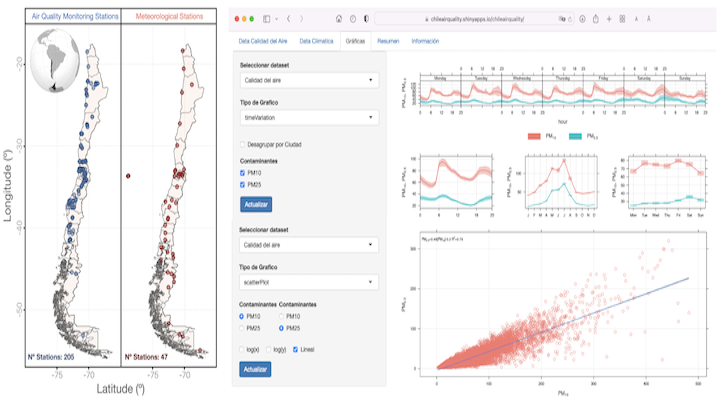
Catalán, Francisco; Chandia, Damián; Toro, Richard; Leiva, Manuel A.
The AtmChile open-source interactive application for exploring air quality and meteorological data in Chile Journal Article
In: Atmosphere, vol. 13, no. 9, pp. 1364, 2022, ISSN: 2073-4433.
Abstract | Links | BibTeX | Dimensions | Tags: 2022, air quality data, Chile, climatological data, data mining, National Air Quality Information System, open-source software, R package
@article{RN2,
title = {The AtmChile open-source interactive application for exploring air quality and meteorological data in Chile},
author = {Francisco Catalán and Damián Chandia and Richard Toro and Manuel A. Leiva},
url = {https://www.mdpi.com/2073-4433/13/9/1364},
doi = {10.3390/atmos13091364},
issn = {2073-4433},
year = {2022},
date = {2022-01-01},
urldate = {2022-01-01},
journal = {Atmosphere},
volume = {13},
number = {9},
pages = {1364},
abstract = {AtmChile is an R package that permits the download and management of data from the National Air Quality Information System (SINCA, Spanish acronyms) and the Chilean Meteorological Directorate (DMC, Spanish acronyms) for multiple air quality and climatological parameters in a simple and intuitive platform. The AtmChile package includes the ChileAirQualityApp, a dashboard for enhancing the data download functions of this package with analysis, visualization, and descriptive statistics tools in a user-friendly manner. The AtmChile offers researchers and the public a highly intuitive open access package to download, validate, visualize, and preliminarily analyze air quality and climatological data available in Chile.},
keywords = {2022, air quality data, Chile, climatological data, data mining, National Air Quality Information System, open-source software, R package},
pubstate = {published},
tppubtype = {article}
}
Seguel, Rodrigo J.; Gallardo, Laura; Osses, Mauricio; Rojas, Néstor Y.; Nogueira, Thiago; Menares, Camilo; Andrade, Maria Fatima; Belalcázar, Luis C.; Carrasco, Paula; Eskes, Henk; Fleming, Zoë L.; Huneeus, Nicolas; Ibarra, Sergio; Landulfo, Eduardo; Leiva, Manuel A.; Mangones, Sonia C.; Morais, Fernando G.; Moreira, Gregori A.; Pantoja, Nicolás; Parraguez, Santiago; Rojas, Jhojan; Rondanelli, Roberto; Andrade, Izabel Silva; Toro, Richard; Yoshida, Alexandre C.
Photochemical sensitivity to emissions and local meteorology in Bogotá, Santiago, and São Paulo Journal Article
In: Elementa: Science of the Anthropocene, vol. 10, no. 1, pp. 00044, 2022, ISSN: 2325-1026.
Abstract | Links | BibTeX | Dimensions | Tags: aerosols, COVID-19 lockdown, emissions, generalized additive model, meteorology, NOx/VOC ratio, ozone, ozone formation, photochemical sensitivity
@article{RN3,
title = {Photochemical sensitivity to emissions and local meteorology in Bogotá, Santiago, and São Paulo},
author = {Rodrigo J. Seguel and Laura Gallardo and Mauricio Osses and Néstor Y. Rojas and Thiago Nogueira and Camilo Menares and Maria Fatima Andrade and Luis C. Belalcázar and Paula Carrasco and Henk Eskes and Zoë L. Fleming and Nicolas Huneeus and Sergio Ibarra and Eduardo Landulfo and Manuel A. Leiva and Sonia C. Mangones and Fernando G. Morais and Gregori A. Moreira and Nicolás Pantoja and Santiago Parraguez and Jhojan Rojas and Roberto Rondanelli and Izabel Silva Andrade and Richard Toro and Alexandre C. Yoshida},
url = {https://online.ucpress.edu/elementa/article/10/1/00044/169476/Photochemical-sensitivity-to-emissions-and-local https://watermark.silverchair.com/elementa.2021.00044.pdf?token=AQECAHi208BE49Ooan9kkhW_Ercy7Dm3ZL_9Cf3qfKAc485ysgAAAt4wggLaBgkqhkiG9w0BBwagggLLMIICxwIBADCCAsAGCSqGSIb3DQEHATAeBglghkgBZQMEAS4wEQQMfFqMCDHZ_s_6DEkpAgEQgIICkX5Muc9YY638Me9SbVmvJS9Kx21Fthj4sZPZIMAkGkkfC6vSusBJ8S5oz2GFI0BzOq_kto77IK9kMvcURf4Hw4vcfmHn80Qxdula-NuPEAwzFe_Te8t91G941Nj-NdjHbgqXS5DNW9hzxx9mlt6LtM9GMDgGK4rAAh5-slUdFDs4ytvPbRr_gqd1l3i3fopns_BQcCMgeDyC6MXJ8AvjylEQhikOu9NTjJ8RPXDGYy-FrwXqhpHeJw_SeXQNfQZjJOJxXSedr8v3DSuScnLVWDpmeqJ53y8TMunH2jzxfulSEUbvMmeePD7lZurgOTCBCZkHA-YHQ0eaRI5bkK5MAYBZ8CI_Sw2BtrbynZg8rn_jFv50Vd_mjUuQJYkFfZSjeyLWeHsTQf6x-liim0uj8EegRq1t6truAEBXTu_Io69q2Z7sBDzNlstQobA5AYk-kgkKY6bD2ZT8FBodHOxRO2EI1SXUbz6IGxYZVAXjiOdFeX42ct7B4vfHGVTwYobc5u26lNNk2ABdNohRFNBEI3RJF-6TSkKc5YYRUHcD5O-lAFOZ1GnFo3JxoDCrEoEaFSnNoFcRmepVDP-I-h5uGOzTjZam3xyNZ2R3on5OXL28Jh-dKWELF6NXANhxI0-CYS6gm4Yu7BxpRZCzi4MOeC0rxIePiJClMDYd60Dwq5n5xbHkc9HIDgQI5f-7DUKMer-J2C5VRrVbXX4YHNosyc9Yhc9kQQXgR8BjW45_lVvRFKs7y6nyF2cRw-JlJfRcsjAQ1rYBY5uWdHxRyxx8IScdKw5830Mv-qdbIf9AsU64krNYlYCUZnq5DOJn53eWEE1XWBrQ9xXV1Zsll63azqnUNjUiRmX7zgfTg-jx2A8YHg},
doi = {10.1525/elementa.2021.00044},
issn = {2325-1026},
year = {2022},
date = {2022-01-01},
urldate = {2022-01-01},
journal = {Elementa: Science of the Anthropocene},
volume = {10},
number = {1},
pages = {00044},
abstract = {2022, This study delves into the photochemical atmospheric changes reported globally during the pandemic by analyzing the change in emissions from mobile sources and the contribution of local meteorology to ozone (O3) and particle formation in Bogotá (Colombia), Santiago (Chile), and São Paulo (Brazil). The impact of mobility reductions (50%–80%) produced by the early coronavirus-imposed lockdown was assessed through high-resolution vehicular emission inventories, surface measurements, aerosol optical depth and size, and satellite observations of tropospheric nitrogen dioxide (NO2) columns. A generalized additive model (GAM) technique was also used to separate the local meteorology and urban patterns from other drivers relevant for O3 and NO2 formation. Volatile organic compounds, nitrogen oxides (NOx), and fine particulate matter (PM2.5) decreased significantly due to motorized trip reductions. In situ nitrogen oxide median surface mixing ratios declined by 70%, 67%, and 67% in Bogotá, Santiago, and São Paulo, respectively. NO2 column medians from satellite observations decreased by 40%, 35%, and 47%, respectively, which was consistent with the changes in mobility and surface mixing ratio reductions of 34%, 25%, and 34%. However, the ambient NO2 to NOx ratio increased, denoting a shift of the O3 formation regime that led to a 51%, 36%, and 30% increase in the median O3 surface mixing ratios in the 3 respective cities. O3 showed high sensitivity to slight temperature changes during the pandemic lockdown period analyzed. However, the GAM results indicate that O3 increases were mainly caused by emission changes. The lockdown led to an increase in the median of the maximum daily 8-h average O3 of between 56% and 90% in these cities.},
keywords = {aerosols, COVID-19 lockdown, emissions, generalized additive model, meteorology, NOx/VOC ratio, ozone, ozone formation, photochemical sensitivity},
pubstate = {published},
tppubtype = {article}
}
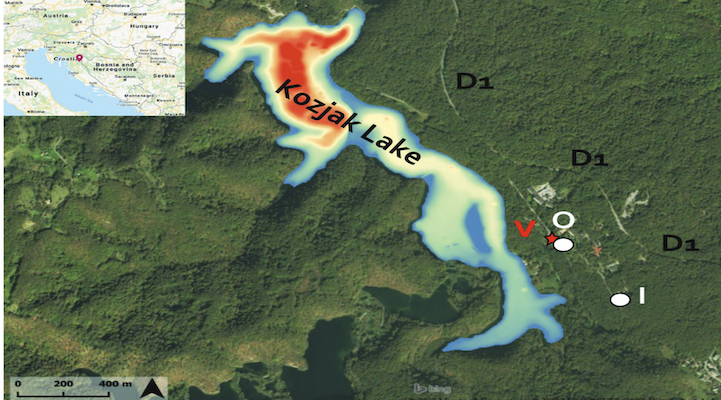
Zvjezdana, Klaić; Leiva, Manuel A.; Brozinčević, Andrijana
In: Archives of Industrial Hygiene and Toxicology, vol. 73, no. 1, pp. 1-14, 2022, ISSN: 1848-6312.
Abstract | Links | BibTeX | Dimensions | Tags: 2022, air pollutants, air quality, croatia, Indoor, meteorological conditions, particulate matter, photochemical reactions, plitvice lakes, visitors, weather conditions
@article{RN4,
title = {Influence of number of visitors and weather conditions on airborne particulate matter mass concentrations at the Plitvice Lakes National Park, Croatia during summer and autumn},
author = {Klaić Zvjezdana and Manuel A. Leiva and Andrijana Brozinčević},
url = {https://www.sciendo.com/article/10.2478/aiht-2022-73-3610
https://sciendo.com/pdf/10.2478/aiht-2022-73-3610},
doi = {10.2478/aiht-2022-73-3610},
issn = {1848-6312},
year = {2022},
date = {2022-01-01},
urldate = {2022-01-01},
journal = {Archives of Industrial Hygiene and Toxicology},
volume = {73},
number = {1},
pages = {1-14},
abstract = {We investigated the influence of local meteorological conditions and number of visitors on ambient particulate matter (PM) mass concentrations and particle fraction ratios at the Plitvice Lakes National Park between July and October 2018. Outdoor mass concentrations of particles with aerodynamic diameters of less than 1, 2.5, and 10 μm (PM1, PM2.5, and PM10, respectively) and indoor PM1 were measured with two light-scattering laser photometers set up near the largest and most visited Kozjak Lake. Our findings suggest that the particles mainly originated from background sources, although some came from local anthropogenic activities. More specifically, increases in both indoor and outdoor mass concentrations coincided with the increase in the number of visitors. Indoor PM1 concentrations also increased with increase in outdoor air temperature, while outdoor PMs exhibited U-shaped dependence (i.e., concentrations increased only at higher outdoor air temperatures). This behaviour and the decrease in the PM1/PM2.5 ratio with higher temperatures suggests that the production and growth of particles is influenced by photochemical reactions. The obtained spectra also pointed to a daily but not to weekly periodicity of PM levels.},
keywords = {2022, air pollutants, air quality, croatia, Indoor, meteorological conditions, particulate matter, photochemical reactions, plitvice lakes, visitors, weather conditions},
pubstate = {published},
tppubtype = {article}
}
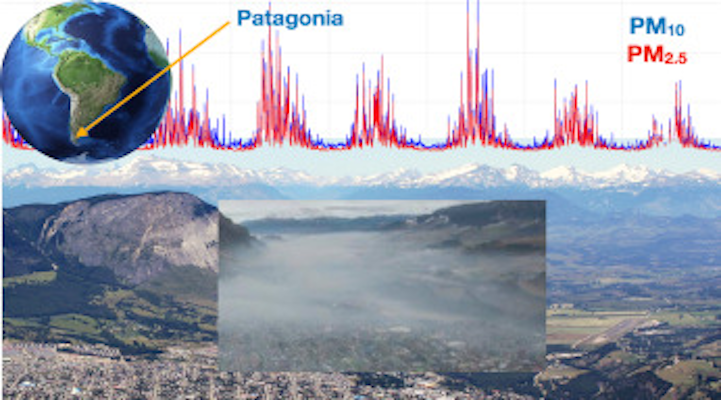
Solís, Rafael; Toro, Richard; Gomez, Luis; Vélez-Pereira, Andrés M.; López, Manuela; Fleming, Zoë L.; Fierro, Nicolás; Leiva, Manuel A.
Long-term airborne particle pollution assessment in the city of Coyhaique, Patagonia, Chile Journal Article
In: Urban Climate, vol. 43, pp. 101144, 2022, ISSN: 22120955.
Abstract | Links | BibTeX | Dimensions | Tags: 2022, air pollutants, air pollution assessment, air quality, firewood emissions, long term trends, particulate matter, patagonia
@article{RN5,
title = {Long-term airborne particle pollution assessment in the city of Coyhaique, Patagonia, Chile},
author = {Rafael Solís and Richard Toro and Luis Gomez and Andrés M. Vélez-Pereira and Manuela López and Zoë L. Fleming and Nicolás Fierro and Manuel A. Leiva},
url = {https://linkinghub.elsevier.com/retrieve/pii/S2212095522000621
https://www.sciencedirect.com/science/article/pii/S2212095522000621?via%3Dihub},
doi = {10.1016/j.uclim.2022.101144},
issn = {22120955},
year = {2022},
date = {2022-01-01},
urldate = {2022-01-01},
journal = {Urban Climate},
volume = {43},
pages = {101144},
abstract = {An air pollution assessment in a small city located in the heart of Chilean Patagonia is presented. Seven years (2014–2020) of PM concentration levels retrieved from two monitoring stations permits an evaluation of the city's pollution variability, the effect of meteorological variables and long-term trends of air pollution. The highest PM concentration levels observed during the coldest months are mainly related to an increasing emission associated with the intensive use of firewood for residential heating and cooking. The most polluted days are associated with low temperatures, low wind speed and high PM2.5/PM10 ratios, which is consistent with the predominance of local firewood sources over background emissions. A decrease in both PM fractions over time has been estimated (PM10: -4.1, CI99%: −5.7 to −2.9 and PM2.5: -2.2, CI99%: −3.5 to −1.3 μg m−3 year−1). However, the annual average PM mass concentrations in Coyhaique exceeded both national and international air quality thresholds. The city reported a percent of annual exceedances of the daily WHO guidelines of 57% for PM10 and 77% for PM2.5. These numbers highlight the serious air pollution problem of the city of Coyhaique, which exhibits air pollution levels comparable to those of many polluted megacities in the world.},
keywords = {2022, air pollutants, air pollution assessment, air quality, firewood emissions, long term trends, particulate matter, patagonia},
pubstate = {published},
tppubtype = {article}
}

Li, Ye; Muñoz-Ibañéz, Franz; Maldonado-Alcaíno, Ana; Jack, Darby; Yan, Beizhan; Xu, Li; Acuña, Marco; Leiva, Manuel A.; Valdés, Ana; Cáceres, Dante D.
Cancer burden disease attributable to PM2.5 and health risk by PM2.5-bound toxic species in two urban Chilean Municipalities Journal Article
In: Aerosol and Air Quality Research, vol. 22, no. 12, pp. 220247, 2022, ISSN: 16808584, 20711409.
Abstract | Links | BibTeX | Dimensions | Tags: 2022, air pollutants, burden disease, health risk assessment, pahs, source apportionment, toxic metals
@article{RN6,
title = {Cancer burden disease attributable to PM2.5 and health risk by PM2.5-bound toxic species in two urban Chilean Municipalities},
author = {Ye Li and Franz Muñoz-Ibañéz and Ana Maldonado-Alcaíno and Darby Jack and Beizhan Yan and Li Xu and Marco Acuña and Manuel A. Leiva and Ana Valdés and Dante D. Cáceres},
url = {https://aaqr.org/articles/aaqr-22-06-oa-0247
https://aaqr.org/articles/aaqr-22-06-oa-0247.pdf},
doi = {10.4209/aaqr.220247},
issn = {16808584, 20711409},
year = {2022},
date = {2022-01-01},
urldate = {2022-01-01},
journal = {Aerosol and Air Quality Research},
volume = {22},
number = {12},
pages = {220247},
abstract = {This study aimed to estimate the environmental cancer disease burden in adults attributable to fine particulate matter (PM2.5) exposure using Ostro's function methodology, and health risk indexes for particle-bound toxic chemicals through hazard quotients (HQ, HI) and carcinogenic risk (CR, CRI) indexes from EPA guidelines, of two urban Chilean Municipalities: Coyhaique and Independencia. Quantification of chemical species (OC, EC, metals, and PAHs) was done at the Lamont-Doherty Earth Observatory of Columbia University, USA. Modern carbon in OC and EC analysis showed that the principal source of PM2.5 emission in Coyhaique was firewood burning compared with Independencia. The total PAHs and B[a]P concentrations were 6.3 and 8.9 times higher in Coyhaique than in Independencia. In contrast, As and Pb levels were significantly greater in Independencia. The HI was 14.5 and 2.37 times the limit considered acceptable (HI > 1) in Coyhaique and Independencia, explained 92.45% by B[a]P and 66.99% by As, respectively. CRI exceeded the threshold (1 x 10-6) in Coyhaique and Independencia, explained by As (75.38%) plus B[a]P (20.30%) and As (97.01%). The attributable fraction (AF) of deaths due to lung cancer from long-term exposure to PM2.5 reached 54% (95% CI: 25–72) in Coyhaique vs. 43% (95% CI: 19–46) in Independencia. The AF for cardiopulmonary cancer were 40% (95% CI: 17–57) and 32% (95% CI: 12–46), respectively. A relevant fraction of the cancer cases and potential expected adverse effects would be attributable to long-term exposure to PM2.5 and the presence of chemical compounds bound to the particles. These results deserve further study to help guide policy in different environments, mainly carcinogenic PM2.5-bound toxic species from other emission sources, particularly firewood burning.},
keywords = {2022, air pollutants, burden disease, health risk assessment, pahs, source apportionment, toxic metals},
pubstate = {published},
tppubtype = {article}
}
2021
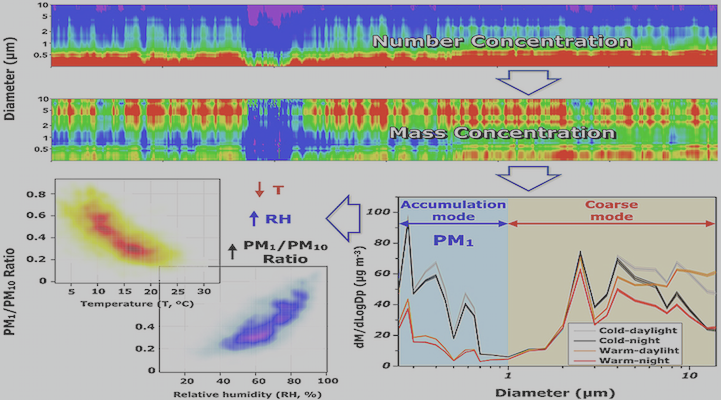
Sánchez, Luis Felipe; Manzano, Carlos A.; Leiva, Manuel A.; Canales, Mauricio; Toro, Richard
Urban atmospheric particle size distribution in Santiago, Chile Journal Article
In: Atmospheric Pollution Research, vol. 12, no. 10, pp. 101201, 2021, ISSN: 13091042.
Abstract | Links | BibTeX | Dimensions | Tags: 2021, aerosol spectrometer, air pollutants, meteorological parameters, particle-size distribution, source apportionment, wood burning emissions
@article{RN7,
title = {Urban atmospheric particle size distribution in Santiago, Chile},
author = {Luis Felipe Sánchez and Carlos A. Manzano and Manuel A. Leiva and Mauricio Canales and Richard Toro},
url = {https://linkinghub.elsevier.com/retrieve/pii/S130910422100266X
https://www.sciencedirect.com/science/article/pii/S130910422100266X?via%3Dihub},
doi = {10.1016/j.apr.2021.101201},
issn = {13091042},
year = {2021},
date = {2021-01-01},
urldate = {2021-01-01},
journal = {Atmospheric Pollution Research},
volume = {12},
number = {10},
pages = {101201},
abstract = {A monitoring campaign of the atmospheric particulate matter (PM) size distribution (between 0.25 and 10 μm in diameter (Dp)) in an urban area with high levels of air pollution between June 2018 and May, 2019 is presented. The relative contribution of 24 size fractions to the total number and mass concentration of PM was analyzed using an aerosol spectrometer. Local meteorological parameters and their effect on the PM concentrations were also evaluated. The size-fractionated particle mass concentrations showed the accumulation (Dp < 1 μm) and coarse (1 μm < Dp < 10 μm) modes. The highest contribution of the accumulation mode was observed during autumn and winter (reaching 99.7 % and 35.2 % of the total number and mass concentrations, respectively). High relative humidity and low temperatures were strongly correlated with high concentrations for the smaller PM fractions, which can be connected to the increase of residential emissions of PM derived from wood burning sources in winter months. The larger PM fractions showed higher concentrations during the spring and summer months, potentially because of dust resuspension due to the high vehicular traffic in the vicinity. High PM concentrations of the larger fractions were favored by the lack of precipitation events and stronger winds during this time of the year. The results showed the importance of the PM1 fraction to improve the source apportionment studies in urban areas and provide information about the potential health effects associated to high PM concentration events.},
keywords = {2021, aerosol spectrometer, air pollutants, meteorological parameters, particle-size distribution, source apportionment, wood burning emissions},
pubstate = {published},
tppubtype = {article}
}
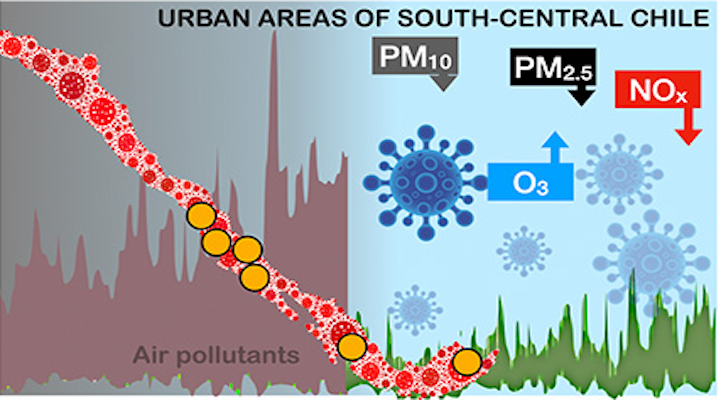
Morales-Solís, Karina; Ahumada, Hernán; Rojas, Jhojan; Urdanivia, Francesco R.; Catalán, Francisco; Claramunt, Tomas; Toro, Richard; Manzano, Carlos A.; Leiva, Manuel A.
The Effect of COVID-19 Lockdowns on the Air Pollution of Urban Areas of Central and Southern Chile Journal Article
In: Aerosol and Air Quality Research, vol. 21, no. 8, pp. 200677, 2021, ISSN: 16808584, 20711409.
Abstract | Links | BibTeX | Dimensions | Tags: 2021, air quality, COVID-19 lockdown, traffic emission rates, wood burning emissions
@article{RN8,
title = {The Effect of COVID-19 Lockdowns on the Air Pollution of Urban Areas of Central and Southern Chile},
author = {Karina Morales-Solís and Hernán Ahumada and Jhojan Rojas and Francesco R. Urdanivia and Francisco Catalán and Tomas Claramunt and Richard Toro and Carlos A. Manzano and Manuel A. Leiva},
url = {https://aaqr.org/articles/aaqr-20-12-covid-0677
https://aaqr.org/articles/aaqr-20-12-covid-0677.pdf},
doi = {10.4209/aaqr.200677},
issn = {16808584, 20711409},
year = {2021},
date = {2021-01-01},
urldate = {2021-01-01},
journal = {Aerosol and Air Quality Research},
volume = {21},
number = {8},
pages = {200677},
abstract = {We present the effects of the confinement and physical distancing policies applied during the COVID-19 pandemic on the concentrations of PM10, PM2.5, NO, NO2 and O3 in 16 cities in central and southern Chile. The period between March and May in 2020 was compared with the corresponding months during 2017-2019, using surface data and satellite information. The relative percent changes in the concentration of atmospheric pollutants, and the meteorological variables observed between these two periods were used to quantify the effects of the lockdowns on the local air quality of the urban areas studied. The results showed statistically significant changes in 11 of the 16 cities. Significant relative changes between +14% and -33% were observed for PM10 in 9 cities; while statistically significant changes between -6% and -48% were evident for PM2.5 in 10 cities. Significant decreases between -27% and -55%, were observed in 4 cities in which NO2 data were available; while significant increases in O3, between 18% and 43%, were found in 4 of the 5 cities with available data. The local meteorological variables did not show significant changes between both periods. In all the cities studied, one of the main PM sources is wood burning for residential heating. Although the quarantine imposed during the health emergency could have induced an increase in residential emissions, these were compensated with the reductions in vehicular and/or industrial emissions. Therefore, these results should be carefully interpreted and should inspire new research considering the social, cultural, and economic factors that could alter the common emission patterns and air quality of urban centers.},
keywords = {2021, air quality, COVID-19 lockdown, traffic emission rates, wood burning emissions},
pubstate = {published},
tppubtype = {article}
}
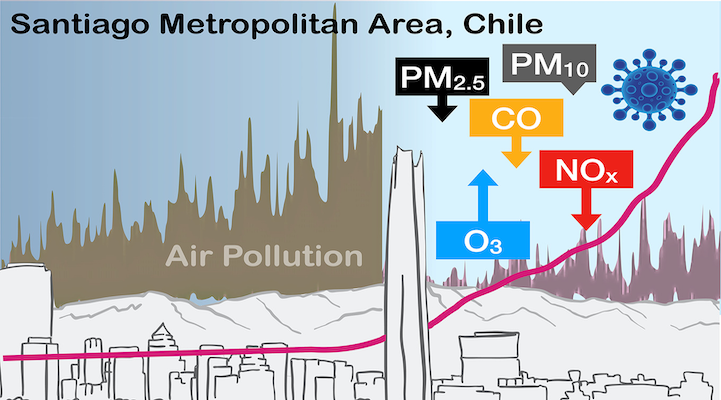
Toro, Richard; Catalán, Francisco; Urdanivia, Francesco R.; Rojas, Jhojan; Manzano, Carlos A.; Seguel, Rodrigo J.; Gallardo, Laura; Osses, Mauricio; Pantoja, Nicolás; Leiva, Manuel A.
Air pollution and COVID-19 lockdown in a large South American city: Santiago Metropolitan Area, Chile Journal Article
In: Urban Climate, vol. 36, pp. 100803, 2021, ISSN: 22120955.
Abstract | Links | BibTeX | Dimensions | Tags: 2021, air pollutants, air quality, COVID-19 lockdown, traffic emission rates
@article{RN9,
title = {Air pollution and COVID-19 lockdown in a large South American city: Santiago Metropolitan Area, Chile},
author = {Richard Toro and Francisco Catalán and Francesco R. Urdanivia and Jhojan Rojas and Carlos A. Manzano and Rodrigo J. Seguel and Laura Gallardo and Mauricio Osses and Nicolás Pantoja and Manuel A. Leiva},
url = {https://linkinghub.elsevier.com/retrieve/pii/S221209552100033X https://www.sciencedirect.com/science/article/pii/S221209552100033X/pdfft?md5=16ffd358b1eaec69d5bba47159bc80f9&pid=1-s2.0-S221209552100033X-main.pdf&isDTMRedir=Y
https://www.sciencedirect.com/science/article/pii/S221209552100033X?via%3Dihub},
doi = {10.1016/j.uclim.2021.100803},
issn = {22120955},
year = {2021},
date = {2021-01-01},
urldate = {2021-01-01},
journal = {Urban Climate},
volume = {36},
pages = {100803},
abstract = {The implementation of confinement and physical distancing measures to restrict people’s activities and transit in the midst of the COVID-19 pandemic allowed us to study how these measures affect the air quality in urban areas with high pollution rates, such as Santiago, Chile. A comparative study between the concentrations of PM10, PM2.5, NOx (NO2 + NO), CO, and O3 during the months of March, April, and May 2020 and the corresponding concentrations during the same period in 2017-2019 is presented. A combination of surface measurements from the official air quality monitoring network of the city, remote satellite measurements, and simulations of traffic activity and road transport emissions allowed us to quantify the change in the average concentrations of each pollutant in the studied period and explore the effects of lockdown scenarios on the local air quality. Average relative changes of traffic emissions (between 61% and 68%) implied statistically significant concentrations reductions of 54%, 13%, and 11% for NOx, CO, and PM2.5, respectively, during the pandemic period compared to the same months of the historical period, at a confidence level of 99%. In contrast, the average concentration of O3 increased by 63% during 2020 compared to 2017-2019. No statistically significant changes were observed for temperature, relative humidity, or wind speed during the same periods. The nonlinear response observed in the pollution levels can be attributed to the changes in the vehicular emission patterns during the pandemic and to the role of other sources of pollution such as residential emissions or secondary PM. The detailed study of pollutants emission patterns and their effect on air quality in urban areas during the pandemic conditions can provide information of interest for designing policies and strategies to prevent and control air pollution.},
keywords = {2021, air pollutants, air quality, COVID-19 lockdown, traffic emission rates},
pubstate = {published},
tppubtype = {article}
}
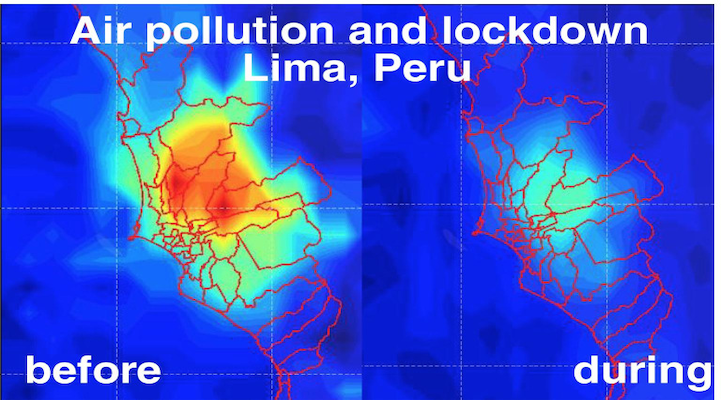
Rojas, Jhojan; Urdanivia, Francesco R.; Garay, Roy A.; García, Alan J.; Enciso, Carlos; Medina, Elvis A.; Toro, Richard; Manzano, Carlos A.; Leiva, Manuel A.
Effects of COVID-19 pandemic control measures on air pollution in Lima metropolitan area, Peru in South America Journal Article
In: Air Quality, Atmosphere & Health, vol. 14, no. 6, pp. 925-933, 2021, ISSN: 1873-9318, 1873-9326.
Abstract | Links | BibTeX | Dimensions | Tags: 2021, air pollutants, air quality, COVID-19 lockdown, megacity, traffic emission rates
@article{RN10,
title = {Effects of COVID-19 pandemic control measures on air pollution in Lima metropolitan area, Peru in South America},
author = {Jhojan Rojas and Francesco R. Urdanivia and Roy A. Garay and Alan J. García and Carlos Enciso and Elvis A. Medina and Richard Toro and Carlos A. Manzano and Manuel A. Leiva},
url = {https://link.springer.com/10.1007/s11869-021-00990-3
https://link.springer.com/content/pdf/10.1007/s11869-021-00990-3.pdf},
doi = {10.1007/s11869-021-00990-3},
issn = {1873-9318, 1873-9326},
year = {2021},
date = {2021-01-01},
urldate = {2021-01-01},
journal = {Air Quality, Atmosphere & Health},
volume = {14},
number = {6},
pages = {925-933},
abstract = {The sanitary measures implemented to control and prevent an increase in infections due to the COVID-19 pandemic have produced an improvement in the air quality of many urban areas around the world. We assessed air quality during the COVID-19 pandemic for particulate matter (PM2.5 and PM10), NO2 and O3 in in metropolitan area of Lima, Peru between pre-lockdown period (February 1 and March 15 of 2020), historical period (March 16 to April 30 2017-2019) and lockdown period (March 16 to April 30, 2020). The complete national lockdown that was implemented in Peru produced statistically significant reductions in the in-air pollutant (PM10 (-40% and -58%), PM2.5 (-31% and -43%) and NO2 (-46% and -48%)), as recorded by the by the ground-based air quality monitoring network throughout the metropolitan area, compared with the corresponding concentrations for the previous weeks and over the same period for 2017-2019. Analysis of the spatial Distribution of satellite data also show decreases in the concentrations of PM10, PM2.5 and NO2 as a result of the containment measures and suspension of activities implemented by the Peruvian government. The concentrations of O3 significantly increased (11% and 170%) as a result of the decrease in the concentration of NO2, confirming that the study area is a hydrocarbon-limited system, as previously reported. The results obtained contribute to the assessment by the regulatory agencies of the possible strategies of control and monitoring of air pollution in the study area.},
keywords = {2021, air pollutants, air quality, COVID-19 lockdown, megacity, traffic emission rates},
pubstate = {published},
tppubtype = {article}
}
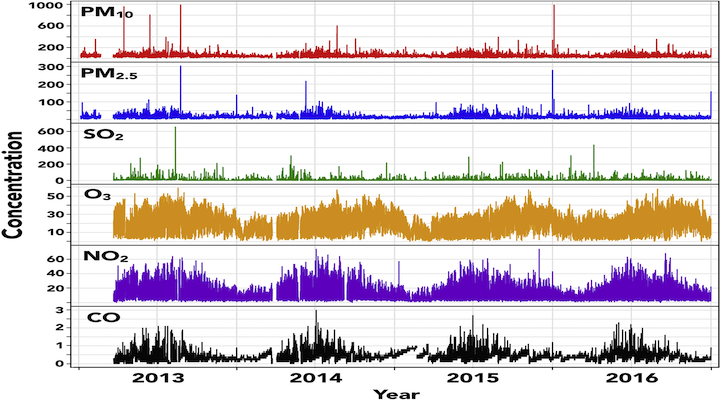
González-Rojas, Claudio H.; Leiva, Manuel A.; Manzano, Carlos A.; Morales, Raúl G. E.; Toro, Richard
Short-term air pollution events in the Atacama desert, Chile Journal Article
In: Journal of South American Earth Sciences, vol. 105, pp. 103010, 2021, ISSN: 08959811.
Abstract | Links | BibTeX | Dimensions | Tags: 2021, air pollutants, atacama desert, copper, meteorological variables, mining sources, particulate matter sulphur dioxide
@article{RN11,
title = {Short-term air pollution events in the Atacama desert, Chile},
author = {Claudio H. González-Rojas and Manuel A. Leiva and Carlos A. Manzano and Raúl G. E. Morales and Richard Toro},
url = {https://linkinghub.elsevier.com/retrieve/pii/S0895981120305538
https://www.sciencedirect.com/science/article/pii/S0895981120305538?via%3Dihub},
doi = {10.1016/j.jsames.2020.103010},
issn = {08959811},
year = {2021},
date = {2021-01-01},
urldate = {2021-01-01},
journal = {Journal of South American Earth Sciences},
volume = {105},
pages = {103010},
abstract = {An evaluation of the concentrations of PM10, PM2.5, SO2, CO, NO2, O3 and meteorological variables recorded between 2013 and 2016 at three continuous monitoring stations in the urban area of Calama (located in the hyper-arid desert from the Atacama) is presented. The results indicated that the recorded concentrations of PM10, PM2.5, and SO2 exceeded the World Health Organization (WHO) daily and annual guidelines throughout the years studied. The diurnal variability of PM10 and PM2.5 concentrations showed that two maxima occurred during mornings and nights, while SO2 concentrations showed a single acute maximum at noon. The relationship between the wind regime in the area and the concentrations of PM10 and PM2.5 implied significant contributions from sources located at the west end of the city: industrial sources (local mining industry) and natural sources (the Atacama desert) during warmer seasons, while local urban sources (vehicles and residential heating) became more relevant during cooler seasons. Maximum SO2 concentrations were connected to changes in the local wind patterns (east to west) that occur around noon in Calama. These changes determined that the emissions from the copper extraction and smelting operations (located north of Calama) could have been transported into the urban area, therefore causing the deterioration of its air quality that is perceived by the local population. No significant trends for SO2 and O3 concentrations were observed during 2013-2016, while an increase of 8.8% year-1 for CO, and a reduction of 5% year-1 for the other pollutants studied was observed.},
keywords = {2021, air pollutants, atacama desert, copper, meteorological variables, mining sources, particulate matter sulphur dioxide},
pubstate = {published},
tppubtype = {article}
}
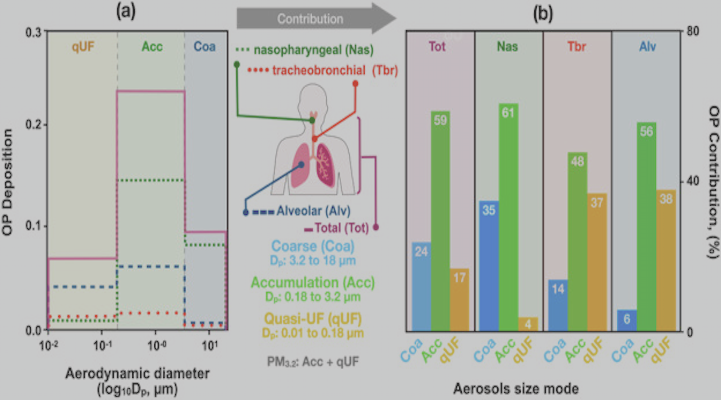
Andrade, Catalina; Molina, Carolina; Sánchez, Luis Felipe; Manzano, Carlos A.; Toro, Richard; Leiva, Manuel A.
Exploring the oxidative potential and respiratory deposition of size-segregated particulate matter at an urban site Journal Article
In: Journal of South American Earth Sciences, vol. 105, pp. 102957, 2021, ISSN: 08959811.
Abstract | Links | BibTeX | Dimensions | Tags: 2021, dithiothreitol, exposure metric, lung deposition model, Oxidative potential, particulate matter, size-segregated aerosols
@article{RN12,
title = {Exploring the oxidative potential and respiratory deposition of size-segregated particulate matter at an urban site},
author = {Catalina Andrade and Carolina Molina and Luis Felipe Sánchez and Carlos A. Manzano and Richard Toro and Manuel A. Leiva},
url = {https://linkinghub.elsevier.com/retrieve/pii/S0895981120305009
https://www.sciencedirect.com/science/article/pii/S0895981120305009?via%3Dihub},
doi = {10.1016/j.jsames.2020.102957},
issn = {08959811},
year = {2021},
date = {2021-01-01},
urldate = {2021-01-01},
journal = {Journal of South American Earth Sciences},
volume = {105},
pages = {102957},
abstract = {According to the current understanding, the adverse health effects of particulate matter (PM) are produced by oxidative stress processes. Hence, the oxidative potential (OP) can be used as an exposure metric for more accurate approaches of the health response to ambient PM. This work explores the relationship between respiratory deposition of size-segregated PM and OP in the city of Santiago, Chile. Size-segregated PM samples were collected at an urban site using a Micro-Orifice Uniform Deposit Impactor (MOUDI) sampler. Dithiothreitol (DTT) loss rates were measured in aqueous PM extracts to estimate the OP for each sample. Size-segregated OP showed a bi-modal distribution with a maximum centered in the accumulation mode (0.18–3.2 μm) and other in the coarse mode (3.2–18 μm). The magnitude of the OP estimated in the acummulation mode was 2.9 ± 0.8 and 2.3 ± 0.6 times the magnitude of the OP estimated in the coarse and quasi-ultrafine mode, respectively. Respiratory deposition calculations indicated that PM3.2 (with diameter less than 3.2 µm) dominated the OP lung deposition with contributions ranging from 65 to 94% in different areas of the human respiratory tract. This was due to the deposition efficiency and greater surface area of these fractions that allowed a more efficient adsorption of active redox chemical species. These results may account for the greater negative impact on lung health of the fine fractions of PM. The characterization of the OP respiratory deposition related to different fractions of PM, can result in adequate metrics to evaluate human exposure to PM and its possible health impacts.},
keywords = {2021, dithiothreitol, exposure metric, lung deposition model, Oxidative potential, particulate matter, size-segregated aerosols},
pubstate = {published},
tppubtype = {article}
}
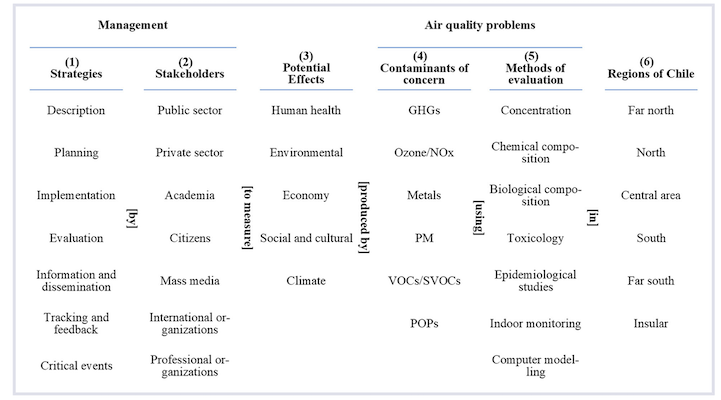
Manzano, Carlos A.; Jácome, Manuel; Syn, Thant; Molina, Carolina; Toro, Richard; Leiva, Manuel A.
Local Air Quality Issues and Research Priorities Through the Lenses of Chilean Experts: An Ontological Analysis Journal Article
In: Integrated Environmental Assessment and Management, vol. 17, no. 1, pp. 273-281, 2021, ISSN: 1551-3777, 1551-3793.
Abstract | Links | BibTeX | Dimensions | Tags: 2021, air pollutants, air quality, multidisciplinary, ontological analysis, policy development, research priorities
@article{RN15,
title = {Local Air Quality Issues and Research Priorities Through the Lenses of Chilean Experts: An Ontological Analysis},
author = {Carlos A. Manzano and Manuel Jácome and Thant Syn and Carolina Molina and Richard Toro and Manuel A. Leiva},
url = {https://onlinelibrary.wiley.com/doi/10.1002/ieam.4320 https://setac.onlinelibrary.wiley.com/doi/pdfdirect/10.1002/ieam.4320?download=true},
doi = {10.1002/ieam.4320},
issn = {1551-3777, 1551-3793},
year = {2021},
date = {2021-01-01},
urldate = {2021-01-01},
journal = {Integrated Environmental Assessment and Management},
volume = {17},
number = {1},
pages = {273-281},
abstract = {Air pollution problems can be large, complex and ill‐structured. They can vary from location to location and combine many complex components: urban expansion, increasing vehicles and industrial emissions, biomass burning, geographic and meteorological conditions, cultural aspects and economic effects. However, the existing research, accumulated knowledge and local research priorities are spread over many disciplines and lack a systematic mapping to help in the management and development of new strategies for researchers and policy makers. Ontological analysis can be used as a tool to capture this complexity through simple natural‐language descriptions and a structured terminology. We describe the development of an ontological framework for Air Quality Management in Chile and its application to evaluate the current state of the research. The process was based on focus groups and was validated by a panel of multidisciplinary experts. We used the developed framework to highlight the topics that have been heavily emphasized, lightly emphasized or overlooked in the Chilean research. The framework developed can help researchers, practitioners and policy makers navigate the domain systematically, and provide the opportunity to correct blind spots by enabling more informed hypotheses dealing with air quality issues at a national level. We believe that this same process applied to different countries will yield different results (due to differences in local knowledge and experience). The framework presented could be used to evaluate other important stakeholders (government, media, NGOs), which will provide a complete picture of how local societies deal with air quality issues at different levels. Additionally, local government institutions should benefit from this analysis to improve funding allocation and open new research opportunities to improve the distribution of the local body of knowledge.},
keywords = {2021, air pollutants, air quality, multidisciplinary, ontological analysis, policy development, research priorities},
pubstate = {published},
tppubtype = {article}
}
2020

Molina, Carolina; Toro, Richard; Manzano, Carlos A.; Canepari, Silvia; Massimi, Lorenzo; Leiva, Manuel A.
Airborne Aerosols and Human Health: Leapfrogging from Mass Concentration to Oxidative Potential Journal Article
In: Atmosphere, vol. 11, no. 9, pp. 917, 2020, ISSN: 2073-4433.
Abstract | Links | BibTeX | Dimensions | Tags: 2020, airborne aerosols, health effects, Oxidative potential, oxidative stress, reactive oxygen species (ROS), reactive species
@article{RN13,
title = {Airborne Aerosols and Human Health: Leapfrogging from Mass Concentration to Oxidative Potential},
author = {Carolina Molina and Richard Toro and Carlos A. Manzano and Silvia Canepari and Lorenzo Massimi and Manuel A. Leiva},
url = {https://www.mdpi.com/2073-4433/11/9/917 https://mdpi-res.com/d_attachment/atmosphere/atmosphere-11-00917/article_deploy/atmosphere-11-00917-v2.pdf?version=1598845771},
doi = {10.3390/atmos11090917},
issn = {2073-4433},
year = {2020},
date = {2020-01-01},
urldate = {2020-01-01},
journal = {Atmosphere},
volume = {11},
number = {9},
pages = {917},
abstract = {The mass concentration of atmospheric particulate matter (PM) has been systematically used in epidemiological studies as an indicator of exposure to air pollutants, connecting PM concentrations with a wide variety of human health effects. However, these effects can be hardly explained by using one single parameter, especially because PM is formed by a complex mixture of chemicals. Current research has shown that many of these adverse health effects can be derived from the oxidative stress caused by the deposition of PM in the lungs. The oxidative potential (OP) of the PM, related to the presence of transition metals and organic compounds that can induce the production of reactive oxygen and nitrogen species (ROS/RNS), could be a parameter to evaluate these effects. Therefore, estimating the OP of atmospheric PM would allow us to evaluate and integrate the toxic potential of PM into a unique parameter, which is related to emission sources, size distribution and/or chemical composition. However, the association between PM and particle-induced toxicity is still largely unknown. In this commentary article, we analyze how this new paradigm could help to deal with some unanswered questions related to the impact of atmospheric PM over human health.},
keywords = {2020, airborne aerosols, health effects, Oxidative potential, oxidative stress, reactive oxygen species (ROS), reactive species},
pubstate = {published},
tppubtype = {article}
}
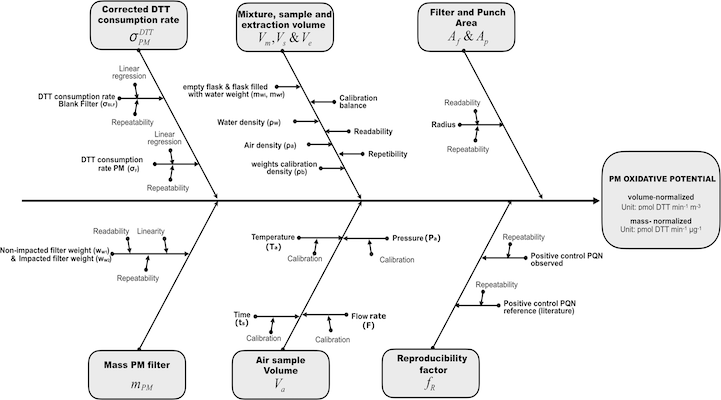
Molina, Carolina; Andrade, Catalina; Manzano, Carlos A.; Toro, Richard; Verma, Vishal; Leiva, Manuel A.
Dithiothreitol-based oxidative potential for airborne particulate matter: an estimation of the associated uncertainty Journal Article
In: Environmental Science and Pollution Research, vol. 27, no. 23, pp. 29672-29680, 2020, ISSN: 0944-1344, 1614-7499.
Abstract | Links | BibTeX | Dimensions | Tags: 2020, airborne particles, dithiothreitol, GUM, health effects, interlaboratory comparisons, metrology, Oxidative potential, particulate matter, uncertainty
@article{RN14,
title = {Dithiothreitol-based oxidative potential for airborne particulate matter: an estimation of the associated uncertainty},
author = {Carolina Molina and Catalina Andrade and Carlos A. Manzano and Richard Toro and Vishal Verma and Manuel A. Leiva},
url = {https://link.springer.com/10.1007/s11356-020-09508-3
https://link.springer.com/content/pdf/10.1007/s11356-020-09508-3.pdf},
doi = {10.1007/s11356-020-09508-3},
issn = {0944-1344, 1614-7499},
year = {2020},
date = {2020-01-01},
urldate = {2020-01-01},
journal = {Environmental Science and Pollution Research},
volume = {27},
number = {23},
pages = {29672-29680},
abstract = {Oxidative stress is considered as one of the main mechanisms by which airborne particles produce adverse health effects. Several methods to estimate the oxidative potential (OP) of particulate matter (PM) have been proposed. Among them, the dithiothreitol (DTT) assay has gained popularity due to its simplicity and overall low implementation cost. Usually, the estimations of OPDTT are based on n-replicates of a set of samples and their associated standard deviation. However, interlaboratory comparisons of OPDTT can be difficult and lead to misinterpretations. This work presents an estimation of the total uncertainty for the OPDTT measurement of PM10 and PM2.5 samples collected in Santiago (Chile), based on recommendations by the Joint Committee for Guides in Metrology and Eurachem. The expanded uncertainty expressed as a percentage of the mass-normalized OPDTT measurements was 18.0% and 16.3% for PM10 and PM2.5 samples respectively. The dominating contributor to the total uncertainty was identified (i.e., DTT consumption rate, related to the regression and repeatability of experimental data), while the volumetric operations (i.e., pipettes) were also important. The results showed that, although the OP measured following the DTT assay has been successfully used to estimate the potential health impacts of airborne PM, uncertainty estimations must be considered before interpreting the results.},
keywords = {2020, airborne particles, dithiothreitol, GUM, health effects, interlaboratory comparisons, metrology, Oxidative potential, particulate matter, uncertainty},
pubstate = {published},
tppubtype = {article}
}
2019
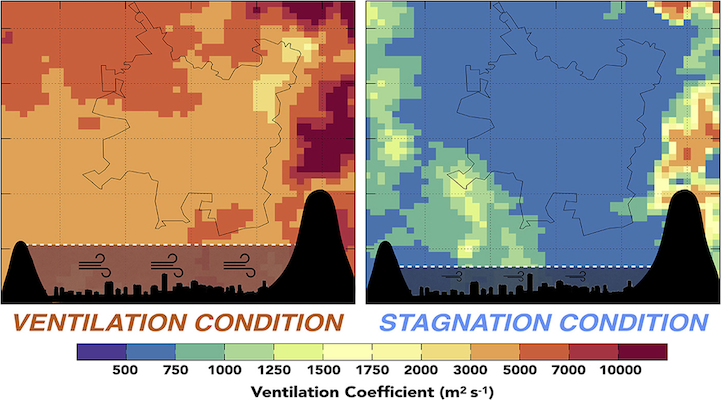
Toro, Richard; Kvakić, Marko; Zvjezdana, Klaić; Koračin, Darko; Morales, Raul G. E.; Leiva, Manuel A.
Exploring atmospheric stagnation during a severe particulate matter air pollution episode over complex terrain in Santiago, Chile Journal Article
In: Environmental Pollution, vol. 244, pp. 705-714, 2019, ISSN: 02697491.
Abstract | Links | BibTeX | Dimensions | Tags: 2019, air pollutans, air pollution, air quality, meteorological measurements, numerical simulations, particulate matter, thermal inversions layers, ventilation coefficient, weather research forecasting
@article{RN16,
title = {Exploring atmospheric stagnation during a severe particulate matter air pollution episode over complex terrain in Santiago, Chile},
author = {Richard Toro and Marko Kvakić and Klaić Zvjezdana and Darko Koračin and Raul G. E. Morales and Manuel A. Leiva},
url = {https://linkinghub.elsevier.com/retrieve/pii/S0269749118311461
https://www.sciencedirect.com/science/article/pii/S0269749118311461?via%3Dihub},
doi = {10.1016/j.envpol.2018.10.067},
issn = {02697491},
year = {2019},
date = {2019-01-01},
urldate = {2019-01-01},
journal = {Environmental Pollution},
volume = {244},
pages = {705-714},
abstract = {This study investigates A severe air quality degradation event occurred in the Santiago Metropolitan Area (SMA), Chile, in June 2014. Meteorological and air quality measurementsfrom 11 stations in the area as well as numerical simulations using the Weather and Research Forecasting (WRF) model were used to explain the main reasons for the occurrence of elevated particulate matter (PM) concentrations. The conditions were characterized with formation of a coastal low in central Chile between the southeastern anticyclone and a high-pressure system over Argentina. At a local scale, these conditions generated a depression at the base of the inversion layer, an increase in the vertical thermal stability, lower humidity and low-wind conditions, which were conducive to a decrease in pollutant dispersion and insufficient ventilation of the polluted air. Measurements and simulations using the WRF model revealed a vertical structure of the boundary layer during these stagnant conditions and provided a basis for a trajectory analysis. The backtrajectory calculation showed that the transport of air parcels was contained in the valley during the highest concentrations. The analysis also enabled the definition of the threshold values of a simple indicator of air pollution (ventilation coefficient, VC), which confirmed the evolution of the episode and divided the observed daily concentrations into two groups, with one including values above the limits prescribed by the national air quality standards (NAQS) and the other including values below these limits. For the SMA, the daily PM concentrations above the NASQ limits were associated with an overall mean threshold value of VC below 500 m2 s-1 (for PM2.5) and 300 m2 s-1 (for PM10). To apply the VC analysis to other pollutants and different geographic locations, different threshold values should be evaluated.},
keywords = {2019, air pollutans, air pollution, air quality, meteorological measurements, numerical simulations, particulate matter, thermal inversions layers, ventilation coefficient, weather research forecasting},
pubstate = {published},
tppubtype = {article}
}
2018
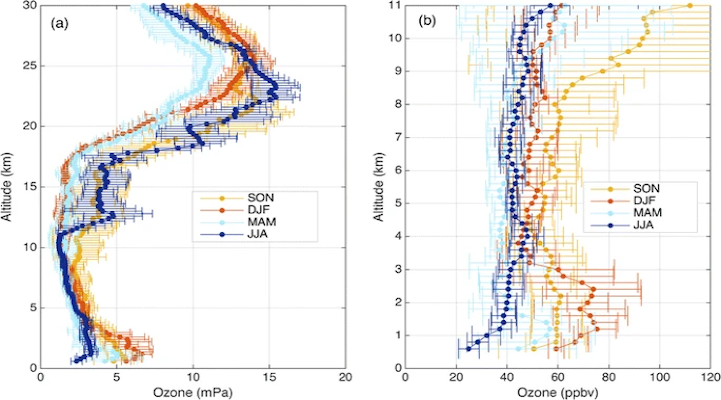
Seguel, Rodrigo J.; Mancilla, Carlos A.; Leiva, Manuel A.
Stratospheric ozone intrusions during the passage of cold fronts over central Chile Journal Article
In: Air Quality, Atmosphere & Health, vol. 11, no. 5, pp. 535-548, 2018, ISSN: 1873-9318, 1873-9326.
Abstract | Links | BibTeX | Dimensions | Tags: 2018, air quality, exchange project maximum impact tololo urban model city, ozone intrusion, ozonesonde, photochemical, stratosphere-troposphere exchange, tropospheric column ozone
@article{RN17,
title = {Stratospheric ozone intrusions during the passage of cold fronts over central Chile},
author = {Rodrigo J. Seguel and Carlos A. Mancilla and Manuel A. Leiva},
url = {http://link.springer.com/10.1007/s11869-018-0558-4
https://link.springer.com/content/pdf/10.1007/s11869-018-0558-4.pdf},
doi = {10.1007/s11869-018-0558-4},
issn = {1873-9318, 1873-9326},
year = {2018},
date = {2018-01-01},
urldate = {2018-01-01},
journal = {Air Quality, Atmosphere & Health},
volume = {11},
number = {5},
pages = {535-548},
abstract = {This study analyzes tropospheric column ozone variability in the southern hemisphere as a function of ozone transport from the stratosphere to the troposphere and photochemical formation. Geographically, the study area was located in the mid-latitudes in South America (33º S), to the west of the Andes mountain range, in an area highly susceptible to stratospheric intrusions. Monthly ozonesonde measurements were recorded in Colina to ascertain seasonal vertical ozone distribution from the surface to the stratosphere between September 2010 and May 2012. Vertical distribution of the tropospheric ozone was measured in Talagante for fronts crossing from west to east in central Chile, during two periods in September 2014 and March 2015. These periods were significantly different in terms of the stratospheric ozone annual cycle and height of the tropopause. Our results showed rapid increases of approximately 50 % in the tropospheric column ozone at time intervals shorter than one week. At the surface level, unusually enhanced ozone levels up to 10 parts per billion volume (ppbv) were observed during nighttime. Additionally, stratosphere-troposphere exchange (STE) preferentially occurred in spring and winter, with higher contribution during spring when the tropospheric column ozone attained its maximum concentration. These results provide valuable information regarding tropospheric ozone, a major local and global climate pollutant, to decision makers. In addition, they provide the research community with experimental data from the southern hemisphere, which helps bridge knowledge gaps in a region that has been rarely studied by national and international scientific communities.},
keywords = {2018, air quality, exchange project maximum impact tololo urban model city, ozone intrusion, ozonesonde, photochemical, stratosphere-troposphere exchange, tropospheric column ozone},
pubstate = {published},
tppubtype = {article}
}
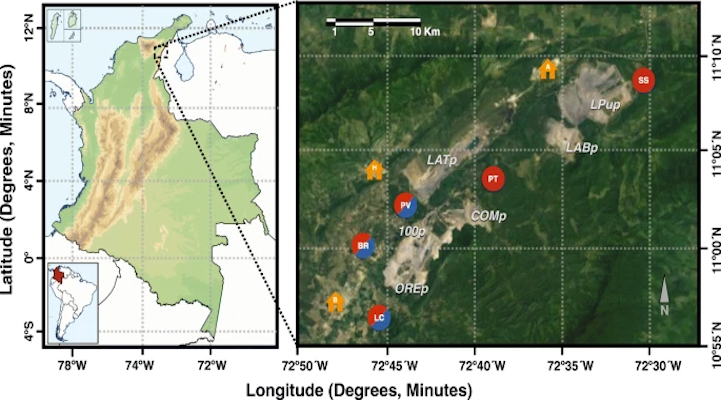
Rojano, Roberto E.; Manzano, Carlos A.; Toro, Richard; Morales, Raul G. E.; Restrepo, Gloria; Leiva, Manuel A.
Potential local and regional impacts of particulate matter emitted from one of the world’s largest open-pit coal mines Journal Article
In: Air Quality, Atmosphere & Health, vol. 11, no. 5, pp. 601-610, 2018, ISSN: 1873-9318, 1873-9326.
Abstract | Links | BibTeX | Dimensions | Tags: 2018, air pollution assessment, air quality, atmospheric transport, long term trends, Open-pit mining, particulate matter
@article{RN18,
title = {Potential local and regional impacts of particulate matter emitted from one of the world’s largest open-pit coal mines},
author = {Roberto E. Rojano and Carlos A. Manzano and Richard Toro and Raul G. E. Morales and Gloria Restrepo and Manuel A. Leiva},
url = {http://link.springer.com/10.1007/s11869-017-0542-4
https://link.springer.com/content/pdf/10.1007/s11869-017-0542-4.pdf},
doi = {10.1007/s11869-017-0542-4},
issn = {1873-9318, 1873-9326},
year = {2018},
date = {2018-01-01},
urldate = {2018-01-01},
journal = {Air Quality, Atmosphere & Health},
volume = {11},
number = {5},
pages = {601-610},
abstract = {This studywas designed to evaluate the atmospheric total suspended particle (TSP) and particulate matter (PM10) concentrations and temporal variability in one of the world’s largest open-pit coal mines (El Cerrejon) located in northeast Colombia, during 2012– 2016. The results showed overall average TSP and PM10 concentrations of 86 μgm−3 (CI95% 84–88 μgm−3) and 34 μgm−3 (CI95% 33–35 μg m−3), respectively, with the highest concentrations between March and August each year. A time trend analysis of the results revealed that PM10 concentrations in particular have significantly increased between 6.2 and 7.7% per year (CI95% 1.2– 12.8% year−1) in several of the monitoring stations. Meteorological parameters were also evaluated. It was observed that NE winds with speeds above 2 m s−1 were significantly correlated with an increase in the concentration of PM10 for selected downwind sites, which suggested that coal mining operations are an important source of atmospheric PM in the area. Regional long-range atmospheric transport scenarios showed potential effects on neighboring municipalities and countries within 72-h transportation events. These highlighted the need to develop new strategies to control the emissions of PM from the local mining industry to comply with local and international guidelines and regulations, particularly when industrial expansion is planned for the near future and relatively large population centers are in the area, of which a high proportion belong to indigenous populations},
keywords = {2018, air pollution assessment, air quality, atmospheric transport, long term trends, Open-pit mining, particulate matter},
pubstate = {published},
tppubtype = {article}
}

Morales, Raul G. E.; Toro, Richard; Morales, Luis; Leiva, Manuel A.
Landfill fire and airborne aerosols in a large city: lessons learned and future needs Journal Article
In: Air Quality, Atmosphere & Health, vol. 11, no. 1, pp. 111-121, 2018, ISSN: 1873-9318, 1873-9326.
Abstract | Links | BibTeX | Dimensions | Tags: 2018, air pollution, emergency management, fire, health impact, Landfill, Municipal solid waste, particulate matter
@article{RN21,
title = {Landfill fire and airborne aerosols in a large city: lessons learned and future needs},
author = {Raul G. E. Morales and Richard Toro and Luis Morales and Manuel A. Leiva},
url = {http://link.springer.com/10.1007/s11869-017-0522-8
https://link.springer.com/content/pdf/10.1007/s11869-017-0522-8.pdf},
doi = {10.1007/s11869-017-0522-8},
issn = {1873-9318, 1873-9326},
year = {2018},
date = {2018-01-01},
urldate = {2018-01-01},
journal = {Air Quality, Atmosphere & Health},
volume = {11},
number = {1},
pages = {111-121},
abstract = {Landfill fires are relatively frequent incidents that can result in severe environmental impacts. On the morning of January 15, 2016, a fire occurred at the Santa Marta Lf in the metropolitan area of Santiago (SMA), Chile. The fire triggered public alarm. In the present work, the impact of the Landfill fire on the air quality of the SMA and the possible impacts on human health are analyzed. According to the information collected, the fire began after a collapse in the Landfill on January 15, 2016. The fire could not be controlled by the Lf operating company and authorities acted late in responding. The results revealed that at the focal point of the fire, particulate matter with an aerodynamic diameter smaller than 2.5 microns (PM2.5) reached concentration levels on the order of 1,000 μgm-3. Three days after the start of the fire, hourly PM2.5 concentration levels above 200 μgm-3 were recorded, at a distance approximately 20 km northeast of where the fire occurred. The PM2.5 concentration levels recommended for the protection of the health of vulnerable persons were subsequently exceeded. These results suggest that a preventive measure should have been the evacuation of the most pollution-sensitive population. An inappropriate management of the emergency was demonstrated. Legislation should be improved by stipulating which sanitary Lfs should be equipped with firefighting equipment. Territorial planning should be improved by considering geographic and meteorological aspects.},
keywords = {2018, air pollution, emergency management, fire, health impact, Landfill, Municipal solid waste, particulate matter},
pubstate = {published},
tppubtype = {article}
}
2017
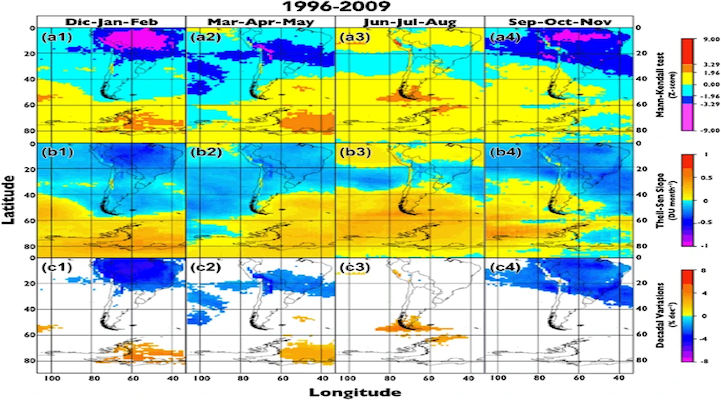
Toro, Richard; Araya, Consuelo; Labra, Felipe; Morales, Luis; Morales, Raul G. E.; Leiva, Manuel A.
Trend and recovery of the total ozone column in South America and Antarctica Journal Article
In: Climate Dynamics, vol. 49, no. 11-12, pp. 3735-3752, 2017, ISSN: 0930-7575, 1432-0894.
Abstract | Links | BibTeX | Dimensions | Tags: 2017, Long-term trend, Mann-Kendall test, Multiple linear regression, ozone depletion, Theil-Sen estimator, Total ozone column
@article{RN19,
title = {Trend and recovery of the total ozone column in South America and Antarctica},
author = {Richard Toro and Consuelo Araya and Felipe Labra and Luis Morales and Raul G. E. Morales and Manuel A. Leiva},
url = {http://link.springer.com/10.1007/s00382-017-3540-1
https://link.springer.com/content/pdf/10.1007/s00382-017-3540-1.pdf},
doi = {10.1007/s00382-017-3540-1},
issn = {0930-7575, 1432-0894},
year = {2017},
date = {2017-01-01},
urldate = {2017-01-01},
journal = {Climate Dynamics},
volume = {49},
number = {11-12},
pages = {3735-3752},
abstract = {South America is one of the most vulnerable areas to stratospheric ozone depletion; consequently, an increased amount of UV radiation reaches the Earth’s sur- face in this region. In this study, we analyzed the long-term trend in the total ozone column (TOC) over the southern part of the South American continent from 1980 to 2009. The database used was obtained by combining several sat- ellite measurements of the TOC on a 1° (latitude) × 1.25° (longitude) grid. Analysis of the long-term trend was per- formed by applying the Theil-Sen estimator and the Mann– Kendall significance test to the deseasonalized time series. The long-term trend was also analyzed over several highly populated urban zones in the study area. Finally, multiple linear regression (MLR) modeling was used to identify and quantify the drivers of interannual variability in the TOC over the study area with a pixel-by-pixel approach. The results showed a decrease in the TOC ranging from −0.3 to −4% dec−1 from 1980 to 2009. On a decadal timescale, there is significant variability in this trend, and a decrease of more than −10% dec−1 was found at high latitudes (1980–1989). However, the trends obtained over much of the study area were not statistically significant. Consider- ing the period from 1980 to 1995, we found a decrease in the TOC of −2.0 ± 0.6% dec−1 at latitudes below 40° S and −6.9 ± 2.0% dec−1 at latitudes above 40° S, for a 99.9% confidence level over most of the study area. Analysis of the period from 1996 to 2009 showed a statistically sig- nificant increase of 2.3 ± 0.1% dec−1 at high latitudes (>60° S), confirming the initial TOC recovery in the Ant- arctic. Despite evidence for initial recovery of the TOC in some parts of the study area between 1996 and 2009, the long-term increase from September to November is not yet statistically significant. In addition, large parts of the study area and most of the urban areas continue to show a decreasing trend in the TOC. The MLR results show that at high latitudes, the main driver of interannual variability in the TOC is the total effective amount of halogens, followed by the eddy heat flux.},
keywords = {2017, Long-term trend, Mann-Kendall test, Multiple linear regression, ozone depletion, Theil-Sen estimator, Total ozone column},
pubstate = {published},
tppubtype = {article}
}

Silva, Jose; Rojas, Jhojan; Norabuena, Magdalena; Molina, Carolina; Toro, Richard; Leiva, Manuel A.
Particulate matter levels in a South American megacity: the metropolitan area of Lima-Callao, Peru Journal Article
In: Environmental Monitoring and Assessment, vol. 189, no. 12, pp. 635, 2017, ISSN: 0167-6369, 1573-2959.
Abstract | Links | BibTeX | Dimensions | Tags: 2017, air pollutants, air pollution assessment, Long-term trend, particulate matter, pollution control, traffic emissions
@article{RN20,
title = {Particulate matter levels in a South American megacity: the metropolitan area of Lima-Callao, Peru},
author = {Jose Silva and Jhojan Rojas and Magdalena Norabuena and Carolina Molina and Richard Toro and Manuel A. Leiva},
url = {http://link.springer.com/10.1007/s10661-017-6327-2
https://link.springer.com/content/pdf/10.1007/s10661-017-6327-2.pdf},
doi = {10.1007/s10661-017-6327-2},
issn = {0167-6369, 1573-2959},
year = {2017},
date = {2017-01-01},
urldate = {2017-01-01},
journal = {Environmental Monitoring and Assessment},
volume = {189},
number = {12},
pages = {635},
abstract = {The temporal and spatial trends in the variability of PM10 and PM2.5 during the period from 2010 to 2015 in the metropolitan area of Lima-Callao, Peru are studied and interpreted in this work. The mean annual concentrations of PM10 and PM2.5 have ranges (averages) of 133-45 μg m-3 (84 μg m-3) and 35-16 μg m-3 (26 μg m-3) for the monitoring sites under study. In general, the highest annual concentrations are observed in the eastern part of the city, which is a result of the pattern of persistent local winds entering from the coast with a south-southwest direction. Seasonal fluctuations in the PM concentrations are observed; these can be explained by subsidence thermal inversion. There is also a daytime pattern that corresponds to the peak traffic of a total of 9 million trips a day. The value of PM2.5 is approximately 40% of the value of PM10. This proportion can be explained by re-suspension of PM10 due to weather conditions. The long-term trends based on the Theil-Sen estimator reveal decreasing PM10 concentrations on the order of -4.3 and -5.3% year-1, in two stations. For the other stations, no significant trend is observed. The MALC is ranked 12th and 16th in terms of PM10 and PM2.5, respectively, out of 39 megacities. The annual World Health Organization thresholds and national air quality standard are exceeded. A large fraction of the population of Lima is exposed to concentrations that exceed protection thresholds. Hence, the development of pollution control and reduction measures is fundamental.},
keywords = {2017, air pollutants, air pollution assessment, Long-term trend, particulate matter, pollution control, traffic emissions},
pubstate = {published},
tppubtype = {article}
}
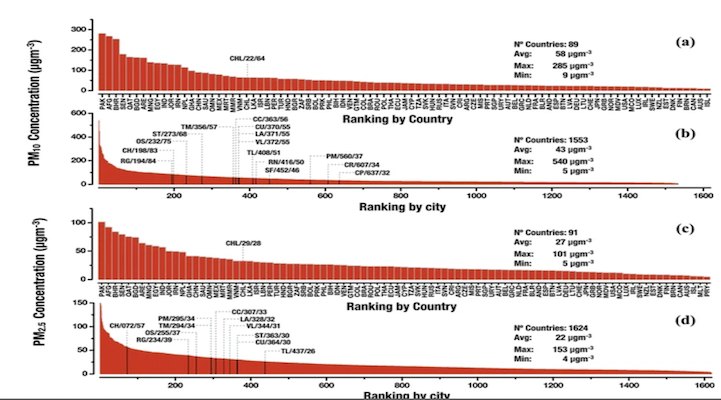
Molina, Carolina; Toro, Richard; Morales, Raul G. E.; Manzano, Carlos A.; Leiva, Manuel A.
Particulate matter in urban areas of south-central Chile exceeds air quality standards Journal Article
In: Air Quality, Atmosphere & Health, vol. 10, no. 5, pp. 653-667, 2017, ISSN: 1873-9318, 1873-9326.
Abstract | Links | BibTeX | Dimensions | Tags: 2017, air pollution assessment, air quality, combustion, firewood burning, meteorological conditions, particulate matter
@article{RN22,
title = {Particulate matter in urban areas of south-central Chile exceeds air quality standards},
author = {Carolina Molina and Richard Toro and Raul G. E. Morales and Carlos A. Manzano and Manuel A. Leiva},
url = {http://link.springer.com/10.1007/s11869-017-0459-y
https://link.springer.com/content/pdf/10.1007/s11869-017-0459-y.pdf},
doi = {10.1007/s11869-017-0459-y},
issn = {1873-9318, 1873-9326},
year = {2017},
date = {2017-01-01},
urldate = {2017-01-01},
journal = {Air Quality, Atmosphere & Health},
volume = {10},
number = {5},
pages = {653-667},
abstract = {This study analyzed air quality in terms of the concentrations of sub-10 µm and sub-2.5 µm particulate matter (PM10 and PM2.5, respectively) recorded at 23 automated public monitoring stations located in 16 cities in south-central Chile (Rancagua, Rengo, San Fernando, Curicó, Talca, Maule, Chillán and Chillán Viejo, Gran Concepción, Coronel, Los Ángeles, Temuco and Padre Las Casas, Valdivia, Osorno, Puerto Montt, Coyhaique and Punta Arenas). In each city, the spatial and temporal distributions of the PM10 and PM2.5 concentrations were recorded at daily, monthly, and yearly intervals. Air quality was evaluated by comparing the annual average concentrations and the maximum daily concentrations of PM10 and PM2.5 with the World Health Organization (WHO) and national standards. The results showed that the limits established in the WHO guidelines and the national standards were systematically exceeded at all the study sites. The highest concentrations of both PM10 and PM2.5 were observed during the fall and winter months (April to September), i.e., the cold period of the year, whereas the lowest concentrations were recorded in the spring and summer months (October to March), i.e., the warm period of the year. Analysis of variance (ANOVA) of the data collected in the warm and cold periods showed that all stations in this study exhibited statistically significant differences between these two periods. During cold periods, burning firewood for heating produces emissions that are a main source of PM. Furthermore, firewood is primarily burned at night when the lowest temperatures occur and when the atmospheric conditions are generally unfavorable for dispersion; thus, pollution accumulates above cities. The levels of PM2.5, the most important type of pollution, exceeded the limit established by the WHO on at least one-third of the days of the year (>120 days) in the cities of Rancagua, Rengo, Curicó, Talca, Chillan, Los Angeles, Temuco, Valdivia, Osorno, Puerto Montt and Coyhaique. Therefore in the cities in southern Chile, the population is exposed to particulate matter concentrations that can have negative health impacts. To improve the air quality conditions in the studied cities, research on heaters and combustion techniques should be promoted, home energy efficiency should be increased to reduce firewood consumption, the firewood certification process should be improved at the national level with a better auditing processes, and the introduction of alternative fuels should be considered for greater energy efficiency at competitive costs.},
keywords = {2017, air pollution assessment, air quality, combustion, firewood burning, meteorological conditions, particulate matter},
pubstate = {published},
tppubtype = {article}
}
2015

Toro, Richard; Seguel, Rodrigo J.; Morales, Raul G. E.; Leiva, Manuel A.
Ozone, nitrogen oxides, and volatile organic compounds in a central zone of Chile Journal Article
In: Air Quality, Atmosphere & Health, vol. 8, no. 6, pp. 545-557, 2015, ISSN: 1873-9318, 1873-9326.
Abstract | Links | BibTeX | Dimensions | Tags: 2015, air pollutants, control strategy, ozone formation potential, Ozone precursors, pollution control, VOC/NOx ratios
@article{RN23,
title = {Ozone, nitrogen oxides, and volatile organic compounds in a central zone of Chile},
author = {Richard Toro and Rodrigo J. Seguel and Raul G. E. Morales and Manuel A. Leiva},
url = {http://link.springer.com/10.1007/s11869-014-0306-3
https://link.springer.com/content/pdf/10.1007/s11869-014-0306-3.pdf},
doi = {10.1007/s11869-014-0306-3},
issn = {1873-9318, 1873-9326},
year = {2015},
date = {2015-01-01},
urldate = {2015-01-01},
journal = {Air Quality, Atmosphere & Health},
volume = {8},
number = {6},
pages = {545-557},
abstract = {The relationships between ozone (O3) and its precursors, nitrogen oxides (NOx) and volatile organic compounds (VOCs), were investigated in the VIR region (34° 10′ S, 71° 36′ W), referred to as Libertador General Bernardo O’Higgins of Chile. Observations were obtained from a field study performed at four monitoring sites, which represented different environmental conditions, i.e., rural-coastal (Marchihue, MA), urban (Rancagua, RA, and Rengo, RE), and semi-urban (Codegua, CO) during the summer (between Feb 1 and Mar 12, 2010). Overall, greater O3 concentrations were identified at the urban sites compared with the semi-urban and rural sites. In addition, the O3 precursor concentrations were high in the early morning hours as a consequence of fresh vehicular emissions (from 11 to 40 ppbv for NO x and from 15 to 36 ppbC for VOC). The total VOC/NO x ratios at the study sites indicated that the formation of O3 was limited by VOCs. Most O3 was formed from ethene, isoprene, propene, 2-methylpropene, m- and p-xylenes, and toluene. These VOCs accounted for more than 50 % of the O3 formation. The m- and p-xylene/ethylbenzene ratio confirmed the reception of aged air masses at the CO site. In contrast, at the RA site, the impact of pollution was primarily local. Control measures should be implemented to prevent O3 exceedances of the National Ambient Air Quality Standard (NAAQS), despite the fact that the current O3 concentrations do not exceed the current 8-h standard of 61 ppbv. These measures should include the control of VOC emissions and their chemical reactivity.},
keywords = {2015, air pollutants, control strategy, ozone formation potential, Ozone precursors, pollution control, VOC/NOx ratios},
pubstate = {published},
tppubtype = {article}
}

Toro, Richard; Córdova, Alicia; Canales, Mauricio; Morales, Raul G. E.; Mardones, Pedro; Leiva, Manuel A.
Trends and threshold exceedances analysis of airborne pollen concentrations in Metropolitan Santiago Chile Journal Article
In: PLOS ONE, vol. 10, no. 5, pp. e0123077, 2015, ISSN: 1932-6203.
Abstract | Links | BibTeX | Dimensions | Tags: 2015, airborne concentrations, allergic rhinoconjunctivitis, long term trends, pollen analysis, Santiago de Chile, urban allergens
@article{RN24,
title = {Trends and threshold exceedances analysis of airborne pollen concentrations in Metropolitan Santiago Chile},
author = {Richard Toro and Alicia Córdova and Mauricio Canales and Raul G. E. Morales and Pedro Mardones and Manuel A. Leiva},
url = {https://dx.plos.org/10.1371/journal.pone.0123077 https://journals.plos.org/plosone/article/file?id=10.1371/journal.pone.0123077&type=printable},
doi = {10.1371/journal.pone.0123077},
issn = {1932-6203},
year = {2015},
date = {2015-01-01},
urldate = {2015-01-01},
journal = {PLOS ONE},
volume = {10},
number = {5},
pages = {e0123077},
abstract = {Pollen is one of the primary causes of allergic rhinoconjunctivitis in urban centers. In the present study, the concentrations of 39 different pollens in the Santiago de Chile metropolitan area over 2009–2013 are characterized. The pollen was monitored daily using Burkard volumetric equipment. The contribution of each type of pollen and the corresponding time trends are evaluated. The concentrations of the pollens are compared with the established threshold levels for the protection of human health. The results show that the total amount of pollen grains originating from trees, grasses, weeds and indeterminate sources throughout the period of the study was 258,496 grains m-3, with an annual average of 51,699±3,906 grains m-3 year-1. The primary source of pollen is Platanus orientalis, which produces 61.8% of the analyzed pollen. Grasses pollen is the third primary component of the analyzed pollen, with a contribution of 5.82%. Among the weeds, the presence of Urticacea (3.74%) is remarkable. The pollination pattern of the trees is monophasic, and the grasses have a biphasic pattern. The trends indicate that the total pollen and tree pollen do not present a time trend that is statistically significant throughout the period of the study, whereas the grass pollen and weed pollen concentrations in the environment present a statistically significant decreasing trend. The cause of this decrease is unclear. The pollen load has doubled over the past decade. When the observed concentrations of the pollens were compared with the corresponding threshold levels, the results indicated that over the period of the study, the pollen concentrations were at moderate, high and very high levels for an average of 293 days per year. Systematic counts of the pollen grains are an essential method for the diagnosis and treatment of patients with pollinosis and for the development of forestation and urban planning strategies.},
keywords = {2015, airborne concentrations, allergic rhinoconjunctivitis, long term trends, pollen analysis, Santiago de Chile, urban allergens},
pubstate = {published},
tppubtype = {article}
}
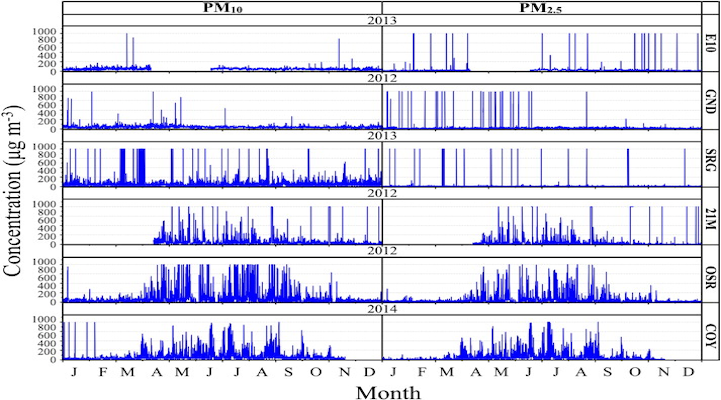
Toro, Richard; Campos, Claudia; Molina, Carolina; Morales, Raul G. E.; Leiva, Manuel A.
Accuracy and reliability of Chile's National Air Quality Information System for measuring particulate matter: Beta attenuation monitoring issue Journal Article
In: Environment International, vol. 82, pp. 101-109, 2015, ISSN: 01604120.
Abstract | Links | BibTeX | Dimensions | Tags: 2015, air quality monitoring, Beta Attenuation, Chilean, data reliability, monitoring air quality system Particulate matter, particulate matter, quality control
@article{RN25,
title = {Accuracy and reliability of Chile's National Air Quality Information System for measuring particulate matter: Beta attenuation monitoring issue},
author = {Richard Toro and Claudia Campos and Carolina Molina and Raul G. E. Morales and Manuel A. Leiva},
url = {https://linkinghub.elsevier.com/retrieve/pii/S0160412015000367
https://www.sciencedirect.com/science/article/pii/S0160412015000367?via%3Dihub},
doi = {10.1016/j.envint.2015.02.009},
issn = {01604120},
year = {2015},
date = {2015-01-01},
urldate = {2015-01-01},
journal = {Environment International},
volume = {82},
pages = {101-109},
abstract = {A critical analysis of Chile's National Air Quality Information System (NAQIS) is presented, focusing on particulate matter (PM) measurement. This paper examines the complexity, availability and reliability of monitoring station information, the implementation of control systems, the quality assurance protocols of the monitoring station data and the reliability of the measurement systems in areas highly polluted by particulate matter. From information available on the NAQIS website, it is possible to confirm that the PM 2.5 (PM 10) data available on the site correspond to 30.8% (69.2%) of the total information available from the monitoring stations. There is a lack of information regarding the measurement systems used to quantify air pollutants, most of the available data registers contain gaps, almost all of the information is categorized as "preliminary information" and neither standard operating procedures (operational and validation) nor assurance audits or quality control of the measurements are reported. In contrast, events that cause saturation of the monitoring detectors located in northern and southern Chile have been observed using beta attenuation monitoring. In these cases, it can only be concluded that the PM content is equal to or greater than the saturation concentration registered by the monitors and that the air quality indexes obtained from these measurements are underestimated. This occurrence has been observed in 12 (20) public and private stations where PM 2.5 (PM 10) is measured. The shortcomings of the NAQIS data have important repercussions for the conclusions obtained from the data and for how the data are used. However, these issues represent opportunities for improving the system to widen its use, incorporate comparison protocols between equipment, install new stations and standardize the control system and quality assurance.},
keywords = {2015, air quality monitoring, Beta Attenuation, Chilean, data reliability, monitoring air quality system Particulate matter, particulate matter, quality control},
pubstate = {published},
tppubtype = {article}
}
2014

Toro, Richard; Morales, Raul G. E.; Canales, Mauricio; Gonzalez-Rojas, Claudio H.; Leiva, Manuel A.
Inhaled and inspired particulates in Metropolitan Santiago Chile exceed air quality standards Journal Article
In: Building and Environment, vol. 79, pp. 115-123, 2014, ISSN: 03601323.
Abstract | Links | BibTeX | Dimensions | Tags: 2014, air quality, long term trends, particulate matter, pollution control, standards compilance
@article{RN26,
title = {Inhaled and inspired particulates in Metropolitan Santiago Chile exceed air quality standards},
author = {Richard Toro and Raul G. E. Morales and Mauricio Canales and Claudio H. Gonzalez-Rojas and Manuel A. Leiva},
url = {https://linkinghub.elsevier.com/retrieve/pii/S0360132314001401
https://www.sciencedirect.com/science/article/pii/S0360132314001401?via%3Dihub},
doi = {10.1016/j.buildenv.2014.05.004},
issn = {03601323},
year = {2014},
date = {2014-01-01},
urldate = {2014-01-01},
journal = {Building and Environment},
volume = {79},
pages = {115-123},
abstract = {The long-term trends and spatial variability of PM2.5 and PM10 over the period between 2000 and 2012 in the Santiago Metropolitan Area, Chile are studied. The annual PM10 and PM2.5 mass concentration ranged between 76 ± 5 and 52 ± 4 μg m−3 and between 32 ± 4 and 24 ± 3, respectively. The large levels of PM observed during the cool season (April–September) compared to the warm season (October–March) can be explained by meteorological conditions and increased emissions. PM2.5 represents approximately 45% ± 5% and 60% ± 10% of PM10 in the warm and cold seasons, respectively. Reductions in PM10 and PM2.5 were observed in the ranges of −2.46 to 0.31 and −3.17 to −1.80% year−1, respectively. For the city, the comprehensive air pollution level declined gradually, illustrating that the air quality improved over the last decade. However, the air quality standards were still being exceeded, indicating the need to update and strengthen the policies to control PM pollution.},
keywords = {2014, air quality, long term trends, particulate matter, pollution control, standards compilance},
pubstate = {published},
tppubtype = {article}
}
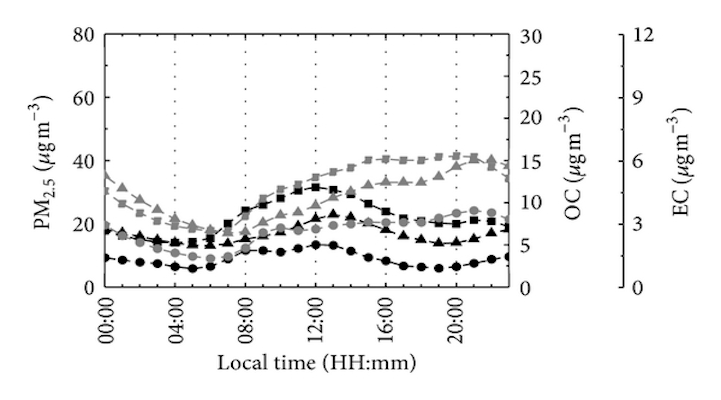
Toro, Richard; Flocchini, Robert; Morales, Raul G. E.; Leiva, Manuel A.
Carbonaceous Aerosols in Fine Particulate Matter of Santiago Metropolitan Area, Chile Journal Article
In: The Scientific World Journal, vol. 2014, pp. 1-12, 2014, ISSN: 2356-6140, 1537-744X.
Abstract | Links | BibTeX | Dimensions | Tags: 2014, air quality standards, carbonaceous aerosols, elemental carbon, organic carbon, particulate matter, pollution control, temporal variation
@article{RN27,
title = {Carbonaceous Aerosols in Fine Particulate Matter of Santiago Metropolitan Area, Chile},
author = {Richard Toro and Robert Flocchini and Raul G. E. Morales and Manuel A. Leiva},
url = {http://www.hindawi.com/journals/tswj/2014/794590/
https://downloads.hindawi.com/journals/tswj/2014/794590.pdf},
doi = {10.1155/2014/794590},
issn = {2356-6140, 1537-744X},
year = {2014},
date = {2014-01-01},
urldate = {2014-01-01},
journal = {The Scientific World Journal},
volume = {2014},
pages = {1-12},
abstract = {Measurements of carbonaceous aerosols in South American cities are limited, and most existing data are of short term and limited to only a few locations. For 6 years (2002–2007), concentrations of fine particulate matter and organic and elemental carbon were measured continuously in the capital of Chile. The contribution of carbonaceous aerosols to the primary and secondary fractions was estimated at three different sampling sites and in the warm and cool seasons. The results demonstrate that there are significant differences in the levels in both the cold (March to August) and warm (September to February) seasons at all sites studied. The percent contribution of total carbonaceous aerosol fine particulate matter was greater in the cool season (53 ± 41%) than in the warm season (44 ± 18%). On average, the secondary organic carbon in the city corresponded to 29% of the total organic carbon. In cold periods, this proportion may reach an average of 38%. A comparison of the results with the air quality standards for fine particulate matter indicates that the total carbonaceous fraction alone exceeds the World Health Organization standard (10 µ g/m 3 ) and the United States Environmental Protection Agency standard (15 µ g/m 3 ) for fine particulate matter.},
keywords = {2014, air quality standards, carbonaceous aerosols, elemental carbon, organic carbon, particulate matter, pollution control, temporal variation},
pubstate = {published},
tppubtype = {article}
}
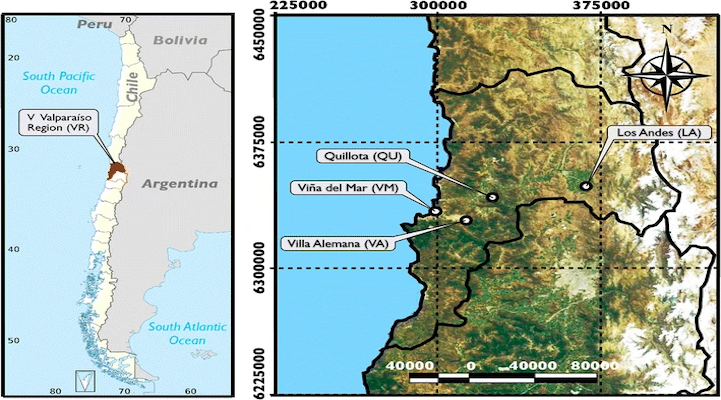
Toro, Richard; Donoso, Camila; Seguel, Rodrigo J.; Morales, Raul G. E.; Leiva, Manuel A.
Photochemical ozone pollution in the Valparaiso Region, Chile Journal Article
In: Air Quality, Atmosphere & Health, vol. 7, no. 1, pp. 1-11, 2014, ISSN: 1873-9318, 1873-9326.
Abstract | Links | BibTeX | Dimensions | Tags: 2014, air pollutants, control strategy, emissions, ozone formation potential, pollution control, VOC/NOx ratios
@article{RN28,
title = {Photochemical ozone pollution in the Valparaiso Region, Chile},
author = {Richard Toro and Camila Donoso and Rodrigo J. Seguel and Raul G. E. Morales and Manuel A. Leiva},
url = {http://link.springer.com/10.1007/s11869-013-0218-7
https://link.springer.com/content/pdf/10.1007/s11869-013-0218-7.pdf},
doi = {10.1007/s11869-013-0218-7},
issn = {1873-9318, 1873-9326},
year = {2014},
date = {2014-01-01},
urldate = {2014-01-01},
journal = {Air Quality, Atmosphere & Health},
volume = {7},
number = {1},
pages = {1-11},
abstract = {The Valparaiso Region is characterized by the presence of air sheds that modulate the general atmospheric circulation with local winds. The ozone concentration in the region increases from the west coast toward the mountainous area, where the concentrations of ozone precursors are lower. In this study, surface ozone (O3), nitric oxide, nitrogen dioxide, nitrogen oxide (NO x ), and volatile organic compounds (VOCs) were measured at four sites, including two upwind urban sites (Viña del Mar (VM) and Villa Alemana (VA)), an upwind suburban site (Quillota (QU)) and a downwind semirural site (Los Andes (LA)) during 01 March–07 April 2010. The purpose of this study is to improve our understanding of the photochemistry of ozone in urban and semirural areas of the Valparaiso Region and the transport of ozone pollution in downwind rural areas. The results show that, in the VM and VA sites, higher concentrations of ozone precursors, NO x , and VOCs, are observed in the early morning hours, which is related to emissions from vehicle traffic, while comparatively lower ozone precursor concentrations are observed in QU and LA. In contrast, higher ozone concentrations are found in LA and QU, and lower concentrations are found in VM and VA. VOC analysis was performed by gas chromatography, and the results show that the VOC composition in the studied sites is similar to and coincident with vehicle emissions. An ozone formation regime limited by VOCs is found in the area. The leading contributors to the ozone-forming potential were ethene, propene, xylene, and toluene, which are also anthropogenic species and account for more than 70 % of O3 formation. Thus, benzenes–toluene–xylenes played the most important role in O3 formation, followed by alkenes, alkanes, aromatic, biogenic, and alkynes during the study periods. The m-, p-xylene/ethylbenzene relation confirms the reception of aged air masses in LA. The results of the present study demonstrate that ozone pollution is a regional problem and that O3 regional transport is associated with such pollution. Finally, the results indicate the need to adopt mitigating measures for ozone pollution that consider the reactivity characteristics of VOCs.},
keywords = {2014, air pollutants, control strategy, emissions, ozone formation potential, pollution control, VOC/NOx ratios},
pubstate = {published},
tppubtype = {article}
}

Toro, Richard; Canales, Mauricio; Flocchini, Robert; Morales, Raul G. E.; Leiva, Manuel A.
Urban Atmospheric Ammonia in Santiago City, Chile Journal Article
In: Aerosol and Air Quality Research, vol. 14, no. 1, pp. 33-44, 2014, ISSN: 16808584, 20711409.
Abstract | Links | BibTeX | Dimensions | Tags: 2014, aerosol chemistry, air pollutants, ammonia, emissions, passive samplers, pollution control, secondary aerosol, water-soluble ions
@article{RN29,
title = {Urban Atmospheric Ammonia in Santiago City, Chile},
author = {Richard Toro and Mauricio Canales and Robert Flocchini and Raul G. E. Morales and Manuel A. Leiva},
url = {https://aaqr.org/articles/aaqr-12-07-oa-0189
https://aaqr.org/articles/aaqr-12-07-oa-0189.pdf},
doi = {10.4209/aaqr.2012.07.0189},
issn = {16808584, 20711409},
year = {2014},
date = {2014-01-01},
urldate = {2014-01-01},
journal = {Aerosol and Air Quality Research},
volume = {14},
number = {1},
pages = {33-44},
abstract = {To improve the current understanding of the ammonia distribution in the major urban area of Chile, measurements of atmospheric NH3 were collected in Santiago during three sampling periods (25 April to 27 May, 11 to 26 June and 27 June to 31 July 2008). Additionally, air quality and meteorological data as well as NH4+, NO3-},
keywords = {2014, aerosol chemistry, air pollutants, ammonia, emissions, passive samplers, pollution control, secondary aerosol, water-soluble ions},
pubstate = {published},
tppubtype = {article}
}

Leiva, Manuel A.; Toro, Richard; Morales, Raul G. E.; Ríos, M. A.; González, M. R.
A study of water-soluble inorganic ions in size-segregated aerosols in atmospheric pollution episode Journal Article
In: International Journal of Environmental Science and Technology, vol. 11, no. 2, pp. 437-448, 2014, ISSN: 1735-1472, 1735-2630.
Abstract | Links | BibTeX | Dimensions | Tags: 2014, Ammonium Nitrate, control strategy, particle-size distribution, Secondary particles, Sulfate, water-soluble ions
@article{RN33,
title = {A study of water-soluble inorganic ions in size-segregated aerosols in atmospheric pollution episode},
author = {Manuel A. Leiva and Richard Toro and Raul G. E. Morales and M. A. Ríos and M. R. González},
url = {http://link.springer.com/10.1007/s13762-013-0221-4
https://link.springer.com/content/pdf/10.1007/s13762-013-0221-4.pdf},
doi = {10.1007/s13762-013-0221-4},
issn = {1735-1472, 1735-2630},
year = {2014},
date = {2014-01-01},
urldate = {2014-01-01},
journal = {International Journal of Environmental Science and Technology},
volume = {11},
number = {2},
pages = {437-448},
abstract = {Particulate matter, the main pollutant in the atmospheric environment of the Santiago city in winter, was analyzed by means of the major water-soluble ionic species obtained under critical episodes of pollution in 2003. The particulate matter samples were collected using the Micro-Orifice uniform deposit impactors, with eight impactor stages connected in series, and the ionic species in particulate matter samples at each stage was analyzed by ion chromatography. While sulfate ion and nitrate ion showed bi-modal distributions, peaking in the fine and coarse mode, ammonium ion displayed a bi-modal size distribution, peaking in the fine and ultra fine mode. The equivalent concentration ratio of ammonium to sulfate was 2.03 ± 0.09, indicating the neutralization of sulfuric acid by ammonia. The excess ammonium ion was associated to nitrate ion. The study of the size distribution of water-soluble inorganic ions in particulate matter supports the notion that secondary aerosols play a significant role in the urban atmosphere.},
keywords = {2014, Ammonium Nitrate, control strategy, particle-size distribution, Secondary particles, Sulfate, water-soluble ions},
pubstate = {published},
tppubtype = {article}
}
2013
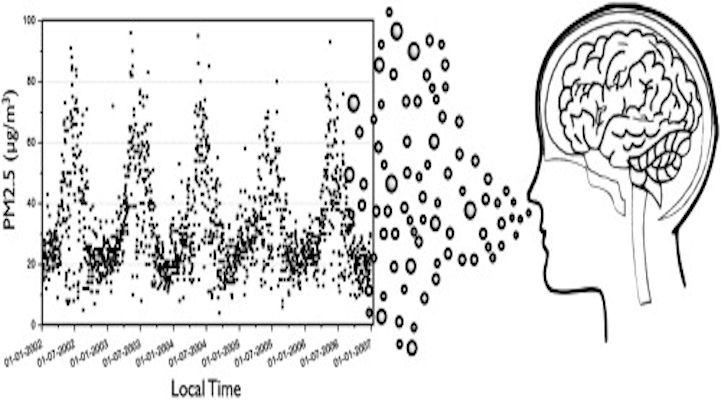
Leiva, Manuel A.; Santibañez, Daniela A.; Ibarra, Sergio; Matus, Patricia; Seguel, Rodrigo J.
A five-year study of particulate matter (PM2.5) and cerebrovascular diseases Journal Article
In: Environmental Pollution, vol. 181, pp. 1-6, 2013, ISSN: 02697491.
Abstract | Links | BibTeX | Dimensions | Tags: 2013, air quality, cerebrovascular diseases, health risk, particulate matter, stroke
@article{RN30,
title = {A five-year study of particulate matter (PM2.5) and cerebrovascular diseases},
author = {Manuel A. Leiva and Daniela A. Santibañez and Sergio Ibarra and Patricia Matus and Rodrigo J. Seguel},
url = {https://linkinghub.elsevier.com/retrieve/pii/S0269749113003175
https://www.sciencedirect.com/science/article/pii/S0269749113003175?via%3Dihub},
doi = {10.1016/j.envpol.2013.05.057},
issn = {02697491},
year = {2013},
date = {2013-01-01},
urldate = {2013-01-01},
journal = {Environmental Pollution},
volume = {181},
pages = {1-6},
abstract = {Cerebrovascular accidents, or strokes, are the second leading cause of mortality and the leading cause of morbidity in both Chile and the rest of the world. However, the relationship between particulate matter pollution and strokes is not well characterized. The association between fine particle concentration and stroke admissions was studied. Data on hospital admissions due to cerebrovascular accidents were collected from the Ministry of Health. Air quality and meteorological data were taken from the Air Quality database of the Santiago Metropolitan Area. Santiago reported 33,624 stroke admissions between January 1, 2002 and December 30, 2006. PM2.5 concentration was markedly seasonal, increasing during the winter. This study found an association between PM2.5 exposure and hospital admissions for stroke; for every PM2.5 concentration increase of 10 μgm-3, the risk of emergency hospital admissions for cerebrovascular causes increased by 1.29% (95% CI 0.552%-2.03%).},
keywords = {2013, air quality, cerebrovascular diseases, health risk, particulate matter, stroke},
pubstate = {published},
tppubtype = {article}
}
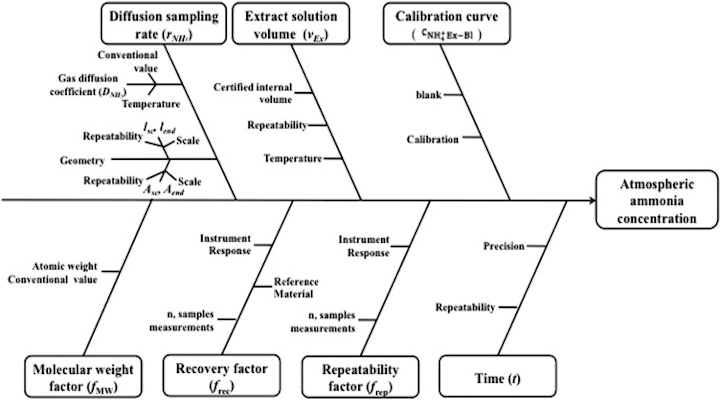
Leiva, Manuel A.; Gonzales, Benjamin; Vargas, Daniela; Toro, Richard; Morales, Raul G. E.
Estimating the uncertainty in the atmospheric ammonia concentration in an urban area by Ogawa passive samplers Journal Article
In: Microchemical Journal, vol. 110, pp. 340-349, 2013, ISSN: 0026265X.
Abstract | Links | BibTeX | Dimensions | Tags: 2013, air quality, atmospheric ammonia concentration, comparability, GUM, ogawa passive sampler, ozone, ozone measurement, uncertainty
@article{RN31,
title = {Estimating the uncertainty in the atmospheric ammonia concentration in an urban area by Ogawa passive samplers},
author = {Manuel A. Leiva and Benjamin Gonzales and Daniela Vargas and Richard Toro and Raul G. E. Morales},
url = {https://linkinghub.elsevier.com/retrieve/pii/S0026265X13000921
https://www.sciencedirect.com/science/article/pii/S0026265X13000921?via%3Dihub},
doi = {10.1016/j.microc.2013.05.004},
issn = {0026265X},
year = {2013},
date = {2013-01-01},
urldate = {2013-01-01},
journal = {Microchemical Journal},
volume = {110},
pages = {340-349},
abstract = {Ammonia, one of the ambient gasses that require environmental monitoring, is typically measured using a passive sampling method. The present work presents an evaluation of the uncertainty according to the Guide to the Expression of Uncertainty in Measurement for the measurement of the atmospheric ammonia concentration as determined by an Ogawa passive sampler, using a colorimetric method. The analytical results report the uncertainty only as a standard deviation of repeated measurements, but not all sources of uncertainty are considered. In this work, the major sources of uncertainty in the measurements are identified as contributions to the linear least-square regression lines, repeatability and recovery. The result, including the expanded uncertainty (k = 2) at a level of confidence of 95%, is 39.2%. The aforementioned results indicate that the Ogawa sampler can be successfully deployed to estimate the atmospheric NH3 and could find wide application in environmental monitoring. However, to obtain correct conclusions, the uncertainty in the measurements must be considered.},
keywords = {2013, air quality, atmospheric ammonia concentration, comparability, GUM, ogawa passive sampler, ozone, ozone measurement, uncertainty},
pubstate = {published},
tppubtype = {article}
}

Seguel, Rodrigo J.; Mancilla, Carlos A.; Rondanelli, Roberto; Leiva, Manuel A.; Morales, Raul G. E.
Ozone distribution in the lower troposphere over complex terrain in Central Chile: Ozone in the lower troposphere in Chile Journal Article
In: Journal of Geophysical Research: Atmospheres, vol. 118, no. 7, pp. 2966-2980, 2013, ISSN: 2169897X.
Abstract | Links | BibTeX | Dimensions | Tags: 2013, chemistry model, complex terrain, long-range transport, mixed boundary layer, ozone ozonesondes, photochemical pollution, residual layer ozone gradients
@article{RN32,
title = {Ozone distribution in the lower troposphere over complex terrain in Central Chile: Ozone in the lower troposphere in Chile},
author = {Rodrigo J. Seguel and Carlos A. Mancilla and Roberto Rondanelli and Manuel A. Leiva and Raul G. E. Morales},
url = {http://doi.wiley.com/10.1002/jgrd.50293 https://agupubs.onlinelibrary.wiley.com/doi/pdfdirect/10.1002/jgrd.50293?download=true},
doi = {10.1002/jgrd.50293},
issn = {2169897X},
year = {2013},
date = {2013-01-01},
urldate = {2013-01-01},
journal = {Journal of Geophysical Research: Atmospheres},
volume = {118},
number = {7},
pages = {2966-2980},
abstract = {Observations were performed in 12 communities of Central Chile in order to determine the horizontal gradients of ozone in the Santiago Basin and surrounding valleys. Higher ozone mixing ratios were found northeast of the Santiago Basin and included east of the Aconcagua Valley (~70 km from Santiago) suggesting that photochemical pollution produced in Santiago is capable of passing through the Chacabuco mountain chain (~1.3 km) and have impact downwind from the regions with the largest NOx and VOC emissions. To complement existing surface observations, ozonesonde and tethersonde campaigns were performed in the Santiago Basin and the Aconcagua Valley. The results suggest ozone can accumulate in layers aloft (e.g., >102 ppb at 2 km) similarly to layers observed in complex topography coastal regions like Southern California. Layers of significant ozone concentrations having a near surface origin were observed above the mixed layer and below the subsidence inversion base. We propose that the ozone in this residual layer can be transported large distances (at least to 70 km) to further penetrate into the local environment under conditions of a well-mixed boundary layer.},
keywords = {2013, chemistry model, complex terrain, long-range transport, mixed boundary layer, ozone ozonesondes, photochemical pollution, residual layer ozone gradients},
pubstate = {published},
tppubtype = {article}
}
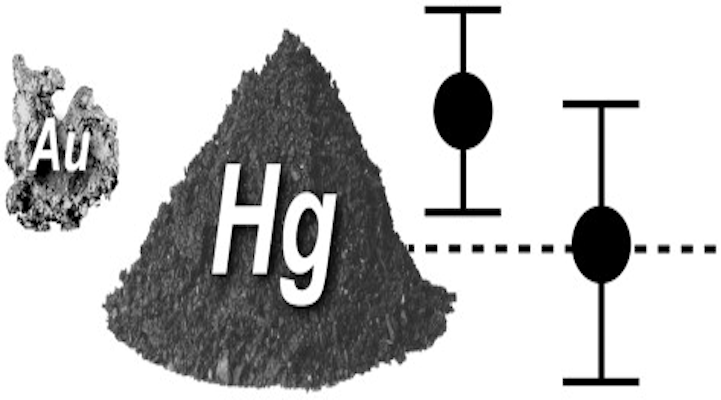
Leiva, Manuel A.; Morales, Sandra
Environmental assessment of mercury pollution in urban tailings from gold mining Journal Article
In: Ecotoxicology and Environmental Safety, vol. 90, pp. 167-173, 2013, ISSN: 01476513.
Abstract | Links | BibTeX | Dimensions | Tags: 2013, Andacollo, artisanal mining, environmental assessments, gold, mercury, soil contamination, soil quality, standards compliance
@article{RN34,
title = {Environmental assessment of mercury pollution in urban tailings from gold mining},
author = {Manuel A. Leiva and Sandra Morales},
url = {https://linkinghub.elsevier.com/retrieve/pii/S0147651312004873
https://www.sciencedirect.com/science/article/pii/S0147651312004873?via%3Dihub},
doi = {10.1016/j.ecoenv.2012.12.026},
issn = {01476513},
year = {2013},
date = {2013-01-01},
urldate = {2013-01-01},
journal = {Ecotoxicology and Environmental Safety},
volume = {90},
pages = {167-173},
abstract = {It is well-known that small-scale artisanal mining is a source of mercury emissions into the environment, mainly from the use of rudimentary technologies that use mercury amalgamation in the extraction process. Mines near Andacollo, which is located in the Coquimbo region of Chile, use primitive methods to mine gold and copper. In this study, we determined the mercury content of gold mining wastes from Andacollo. At each site, we randomly sampled the soil at the surface and at a depth of 2 m following the ISO 10381 guidelines. Mercury analysis was performed with a direct mercury analyzer. At least one site was contaminated at a mercury concentration of 13.6±1.4 mg kg−1, which was above the international recommendations that were set by the Canadian Council of Ministers of the Environment's soil quality guidelines (CA-SQG) and the Dutch guidelines (NL-RIVM). At least four of the fourteen sites in this study were within the control and tolerance levels of these recommendations. Better characterization of these sites is required to establish whether they represent a risk to the local community. Based on the US-EPA recommendations, which have a higher tolerance limit, none of the fourteen sites should pose a risk to humans.},
keywords = {2013, Andacollo, artisanal mining, environmental assessments, gold, mercury, soil contamination, soil quality, standards compliance},
pubstate = {published},
tppubtype = {article}
}

Leiva, Manuel A.; Morales, Sandra; Segura, Rodrigo
In: Water, Air, & Soil Pollution, vol. 224, no. 2, pp. 1390, 2013, ISSN: 0049-6979, 1573-2932.
Abstract | Links | BibTeX | Dimensions | Tags: 2013, cold vapour atomic absorption, GUM, mercury analysis, metrology, standards compliance, thermal decomposition amalgamation, uncertainty
@article{RN35,
title = {Comparative Measurements and their Compliance with Standards of Total Mercury Analysis in Soil by Cold Vapour and Thermal Decomposition, Amalgamation and Atomic Absorption Spectrometry},
author = {Manuel A. Leiva and Sandra Morales and Rodrigo Segura},
url = {http://link.springer.com/10.1007/s11270-012-1390-3
https://link.springer.com/content/pdf/10.1007/s11270-012-1390-3.pdf},
doi = {10.1007/s11270-012-1390-3},
issn = {0049-6979, 1573-2932},
year = {2013},
date = {2013-01-01},
urldate = {2013-01-01},
journal = {Water, Air, & Soil Pollution},
volume = {224},
number = {2},
pages = {1390},
abstract = {Two methods to measure mercury concentration in soil are compared, and their compliance with international standards is determined: cold vapour atomic absorption spectrometry and thermal decomposition, amalgamation and atomic absorption spectrophotometry. The detection limit, quantification limit and uncertainty of these two analytical methods were evaluated and compared. The results indicated that thermal decomposition, amalgamation and atomic absorption spectrophotometry had a lower quantification limit and uncertainty than cold vapour atomic absorption spectrometry (quantification limit, 0.27 vs. 0.63 mg kg−1; expanded uncertainty, 9.30 % vs. 10.8 %, respectively). Thermal decomposition, amalgamation and atomic absorption spectrophotometry allowed the determination of the base values for the concentration of mercury in soil recommended by international standards, achieving a lower detection limit than cold vapour atomic absorption spectrometry under the study conditions. In addition, thermal decomposition, amalgamation and atomic absorption spectrophotometry represent a more environmentally friendly alternative for mercury determination because this method uses fewer reagents and therefore generates less waste.},
keywords = {2013, cold vapour atomic absorption, GUM, mercury analysis, metrology, standards compliance, thermal decomposition amalgamation, uncertainty},
pubstate = {published},
tppubtype = {article}
}
2012
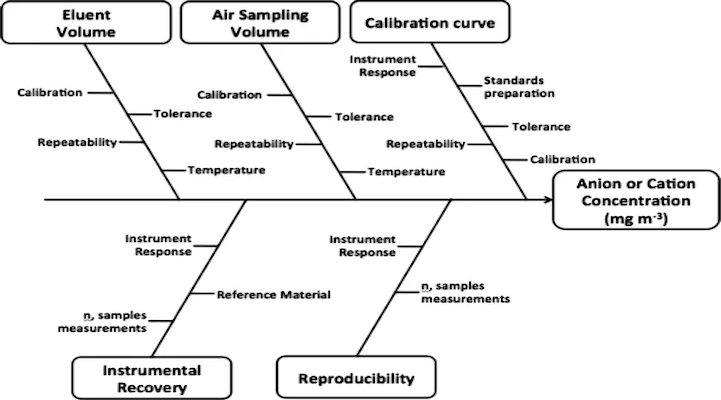
Leiva, Manuel A.; Araya, Consuelo; Alvarado, Ana Maria; Seguel, Rodrigo J.
Uncertainty estimation of anions and cations measured by ion chromatography in fine urban ambient particles Journal Article
In: Accreditation and Quality Assurance, vol. 17, no. 1, pp. 53-63, 2012, ISSN: 0949-1775, 1432-0517.
Abstract | Links | BibTeX | Dimensions | Tags: 2012, air quality, anions, cations, comparability, GUM, ozone, ozone measurement, particulate matter, uncertainty, water-soluble ions
@article{RN36,
title = {Uncertainty estimation of anions and cations measured by ion chromatography in fine urban ambient particles},
author = {Manuel A. Leiva and Consuelo Araya and Ana Maria Alvarado and Rodrigo J. Seguel},
url = {http://link.springer.com/10.1007/s00769-011-0844-4
https://link.springer.com/content/pdf/10.1007/s00769-011-0844-4.pdf},
doi = {10.1007/s00769-011-0844-4},
issn = {0949-1775, 1432-0517},
year = {2012},
date = {2012-01-01},
urldate = {2012-01-01},
journal = {Accreditation and Quality Assurance},
volume = {17},
number = {1},
pages = {53-63},
abstract = {The present work presents a measurement uncertainty evaluation according to Guide to the Expression of Uncertainty in Measurement (GUM) of the concentration of the cations K+ and Li+ and anions NO −23 and SO −24 in fine airborne particulate matter, refers to particles less than 2.5 μm in diameter (PM2.5), as measured by ion chromatography (US-EPA 300 method). The GUM method is not typically used to report uncertainty. In general, the analytical results only report the measurement’s standard deviation under repetition as an uncertainty; thus, not all sources of uncertainty are considered. In this work, the major sources of uncertainty regarding the measurements were identified as contributions to linear least square regression lines, repeatability, precision, and trueness. The expanded uncertainty was approximately 20% for anions and cations. The largest contribution to uncertainty was found to be repeatability.},
keywords = {2012, air quality, anions, cations, comparability, GUM, ozone, ozone measurement, particulate matter, uncertainty, water-soluble ions},
pubstate = {published},
tppubtype = {article}
}
Seguel, Rodrigo J.; Morales, Raul G. E.; Leiva, Manuel A.
Ozone weekend effect in Santiago, Chile Journal Article
In: Environmental Pollution, vol. 162, pp. 72-79, 2012, ISSN: 02697491.
Abstract | Links | BibTeX | Dimensions | Tags: 2012, air pollutants, Chile, ozone weekend effect, pollution control, santiago, VOC/NOx ratios
@article{RN37,
title = {Ozone weekend effect in Santiago, Chile},
author = {Rodrigo J. Seguel and Raul G. E. Morales and Manuel A. Leiva},
url = {https://linkinghub.elsevier.com/retrieve/pii/S0269749111005896
https://www.sciencedirect.com/science/article/pii/S0269749111005896?via%3Dihub},
doi = {10.1016/j.envpol.2011.10.019},
issn = {02697491},
year = {2012},
date = {2012-01-01},
urldate = {2012-01-01},
journal = {Environmental Pollution},
volume = {162},
pages = {72-79},
abstract = {The study examined weekday–weekend differences in ozone, NOx (NO and NO2) and VOC concentrations in Santiago, Chile, from 1999 to 2007. The results provide evidence for the occurrence of an atmospheric phenomenon that produces higher ozone concentrations during weekends despite lower concentrations of ozone precursors. This phenomenon is known as the weekend effect (WE). The overall ozone decrease since the spring of 2004 was a consequence of the implementation of several urban pollution control measures. Although these measures caused a decline in the number of days that exceed the national standard from two-thirds to one-third of summer days, the WE, which became statistically significant beginning in September 2004, could not be eliminated. Furthermore, VOC/NOx ratios decreased during the same period (2004), especially in the most industrialized area of Santiago. Similarly, under these regimes, the VOC/NOx ratios were higher on Sundays than on weekdays and caused higher ozone concentrations on Sundays.},
keywords = {2012, air pollutants, Chile, ozone weekend effect, pollution control, santiago, VOC/NOx ratios},
pubstate = {published},
tppubtype = {article}
}
2011
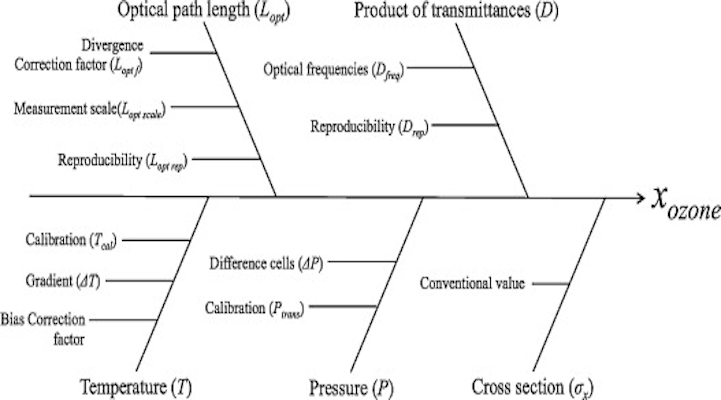
Leiva, Manuel A.; Araya, Consuelo; Mancilla, Carlos A.; Seguel, Rodrigo J.; Norris, James E.
Uncertainty of ozone measurements with the primary standard reference photometer (SRP45) Journal Article
In: Talanta, vol. 86, pp. 71-81, 2011, ISSN: 00399140.
Abstract | Links | BibTeX | Dimensions | Tags: 2011, comparability, GUM, metrology, ozone, ozone measurement, primary standard reference photometer (SRP), uncertainty
@article{RN38,
title = {Uncertainty of ozone measurements with the primary standard reference photometer (SRP45)},
author = {Manuel A. Leiva and Consuelo Araya and Carlos A. Mancilla and Rodrigo J. Seguel and James E. Norris},
url = {https://linkinghub.elsevier.com/retrieve/pii/S0039914011007065
https://www.sciencedirect.com/science/article/pii/S0039914011007065?via%3Dihub},
doi = {10.1016/j.talanta.2011.08.006},
issn = {00399140},
year = {2011},
date = {2011-01-01},
urldate = {2011-01-01},
journal = {Talanta},
volume = {86},
pages = {71-81},
abstract = {A comparison of the ozone primary reference standard photometer serial number 45 (SRP45) against the National Institute of Standards and Technology (NIST) instruments, serial number 0 (SRP0) and 2 (SRP2), has been performed in order to establish the traceability and comparability of ozone measurements made by the Chilean atmospheric science community. A complete uncertainty budget was developed for SRP45, using a GUM approach. The results of the comparisons allow us to conclude that SRP45, SRP0 and SRP2 are comparable according to internationals criteria.},
keywords = {2011, comparability, GUM, metrology, ozone, ozone measurement, primary standard reference photometer (SRP), uncertainty},
pubstate = {published},
tppubtype = {article}
}
2009

Seguel, Rodrigo J.; Morales, Raul G. E.; Leiva, Manuel A.
Estimations of primary and secondary organic carbon formation in PM2.5 aerosols of Santiago City, Chile Journal Article
In: Atmospheric Environment, vol. 43, no. 13, pp. 2125-2131, 2009, ISSN: 13522310.
Abstract | Links | BibTeX | Dimensions | Tags: 2009, air pollutants, chemical characterisation, Chile, particulate matter, santiago, secondary organic carbon
@article{RN39,
title = {Estimations of primary and secondary organic carbon formation in PM2.5 aerosols of Santiago City, Chile},
author = {Rodrigo J. Seguel and Raul G. E. Morales and Manuel A. Leiva},
url = {https://linkinghub.elsevier.com/retrieve/pii/S1352231009000533
https://www.sciencedirect.com/science/article/pii/S1352231009000533?via%3Dihub},
doi = {10.1016/j.atmosenv.2009.01.029},
issn = {13522310},
year = {2009},
date = {2009-01-01},
urldate = {2009-01-01},
journal = {Atmospheric Environment},
volume = {43},
number = {13},
pages = {2125-2131},
abstract = {High concentration of fine airborne particulates is considered one of the major environmental pollutants in Santiago, the Chilean Capital city, which in 1997 was declared a PM10 saturated zone. To date there is no control of the amounts of fine and coarse aerosols concentrations and the source and chemical characterizations of the PM2.5 particulates in the carbonaceous fractions are not well known even though this fraction could be represented almost the 50% in mass of the PM2.5. In this work, we present for the first time determinations of primary organic aerosol (POA) and secondary organic aerosol composition (SOA) fractions of the total mass of PM2.5 particulates collected in the urban atmosphere of Santiago City. Our purpose is to know the anthropogenic contributions to the formation of SOA. To accomplish this we used the elemental carbon (EC) and organic carbon (OC) determinations developed by automatic monitoring stations installed in the city during the period 2002–2005, with a particular analysis of the summer time occurred in February 2004. Based on the EC tracer method, we have estimated the POA and SOA fraction and our data permit us to estimate the SOA reaching up to 20% of total organic aerosol matter, in good agreement to other measurements observed in large cities of Europe and U.S.A.},
keywords = {2009, air pollutants, chemical characterisation, Chile, particulate matter, santiago, secondary organic carbon},
pubstate = {published},
tppubtype = {article}
}
2008
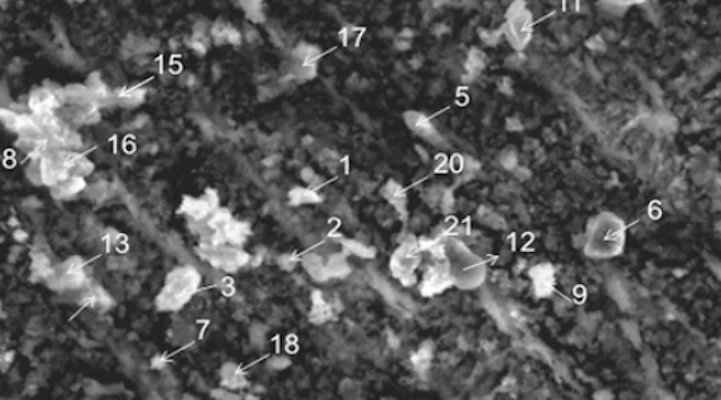
Morata, Diego; Polvé, Mirelle; Valdés, Ana; Belmar, M.; Dinator, M. I.; Silva, M.; Leiva, Manuel A.; Aigouy, T.; Morales, J. R.
Characterisation of aerosol from Santiago, Chile: an integrated PIXE–SEM–EDX study Journal Article
In: Environmental Geology, vol. 56, no. 1, pp. 81-95, 2008, ISSN: 0943-0105, 1432-0495.
Abstract | Links | BibTeX | Dimensions | Tags: 2008, air pollutants, chemical characterisation, Chile, geochemistry, morphological analysis, particuate matter, proton-induced X-ray emission (PIXE), santiago, scanning electron microscopy (SEM), trace-metals
@article{RN40,
title = {Characterisation of aerosol from Santiago, Chile: an integrated PIXE–SEM–EDX study},
author = {Diego Morata and Mirelle Polvé and Ana Valdés and M. Belmar and M. I. Dinator and M. Silva and Manuel A. Leiva and T. Aigouy and J. R. Morales},
url = {http://link.springer.com/10.1007/s00254-007-1141-8
https://link.springer.com/content/pdf/10.1007/s00254-007-1141-8.pdf},
doi = {10.1007/s00254-007-1141-8},
issn = {0943-0105, 1432-0495},
year = {2008},
date = {2008-01-01},
urldate = {2008-01-01},
journal = {Environmental Geology},
volume = {56},
number = {1},
pages = {81-95},
abstract = {Santiago de Chile is a big city with huge air quality problems, being one of the most polluted cities in the world. This is aggravated during winter by the topography and meteorological conditions of the city. Although public policies have been developed to minimise the atmospheric aerosol pollution, there is a lack of adequate knowledge and poor characterisation of these aerosols (in its PM2.5 and PM10 fractions). In this study we sampled atmospheric particles during winter in two distinct areas of Santiago: downtown (Teatinos Street) and in a more residential area (Macul). Major (Si, Al, Fe, Ca and K) and some trace element (S, Cl, Ti, P, Cr, Cu and Zn) compositions were obtained by proton-induced X-ray emission (PIXE). Morphological, type and chemical characterisation was also performed using scanning electron microscopy (SEM) coupled with an energy dispersive X-ray microanalysis system (SEM–EDX). Besides the carbon particles, the contribution of which can be quite important in the atmospheric aerosol, especially in downtown, unambiguously lithogenic (i.e. of geological origin) particles and elements are the second highest contributors. Enrichment factor calculation, together with particle identification and element correlation allow the origin of some elements and particles to be traced, revealing anthropogenic origins for some of them that are specific to the Santiago area.},
keywords = {2008, air pollutants, chemical characterisation, Chile, geochemistry, morphological analysis, particuate matter, proton-induced X-ray emission (PIXE), santiago, scanning electron microscopy (SEM), trace-metals},
pubstate = {published},
tppubtype = {article}
}
2002
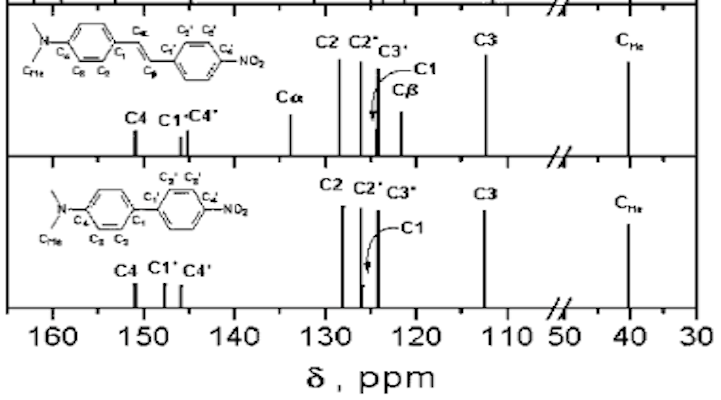
Leiva, Manuel A.; Vargas, Victor; Morales, Raúl G. E.
In: Spectroscopy Letters, vol. 35, no. 4, pp. 611-624, 2002, ISSN: 0038-7010, 1532-2289.
Abstract | Links | BibTeX | Tags: 13C-NMR spectroscopy, 2002, Electron-donor-benzylidenanilines, long distance electronic effects, Molecular orbital calculations
@article{RN41,
title = {Bridge effect of the C=N bond and long distance electronic effects of electron-donor (d) substituents on n-(4-d-benzylidene)-4-nitroanilines and n-(4-nitrobenzylidene)-4-d-aniline},
author = {Manuel A. Leiva and Victor Vargas and Raúl G. E. Morales},
url = {https://www.tandfonline.com/doi/full/10.1081/SL-120013894},
issn = {0038-7010, 1532-2289},
year = {2002},
date = {2002-01-01},
urldate = {2002-01-01},
journal = {Spectroscopy Letters},
volume = {35},
number = {4},
pages = {611-624},
abstract = {By means of 13C-NMR spectroscopy and ab initio molecular orbital theory calculations we have analyzed the bridge effect of the ˭N bond and the long distance electronic effect of the electron-donor substituents (D: -NO2, -Cl, -H, -CH3, -OCH3, and -N(CH3)2) on N-(4-D-benzylidene)-4-nitroanilines (DCNA) and N-(4-nitrobenzylidene)-4-D-ani-line (DNCA), in the ground electronic state. From the 13C-NMR spectral assignment signals and our molecular orbital calculations on a Gaussian HF/6-31G* basis set, we have found a linear functional dependence of the chemical shifts on the electronic charge of the C1, C4, 1′ and C4′ centers. Furthermore, we have determined the effect of the nitrogen centres on the molecular bridge by means of the chemical shifts of the carbon centres, the theoretical charge densities and the dipolar moments. From an electronic point of view, our results permit determine in a quantitative way the local charge accumulation capacity on the ˭N bond induced by the electron-donor substituent, as well as, determine the bridge effect on the dipolar moment.},
keywords = {13C-NMR spectroscopy, 2002, Electron-donor-benzylidenanilines, long distance electronic effects, Molecular orbital calculations},
pubstate = {published},
tppubtype = {article}
}
2000

Leiva, Manuel A.; Morales, Raul G. E.
Bridge effect of the C=C, C=N and N=N bonds on the long distance electronic charge transfer of para‒substituted stilbenoid compounds Journal Article
In: Spectroscopy, vol. 14, no. 4, pp. 259-267, 2000, ISSN: 0712-4813, 1875-922X.
Abstract | Links | BibTeX | Dimensions | Tags: 13C-NMR spectroscopy, 2000, long distance electronic effects, Molecular orbital calculations, stilbenoid compounds
@article{RN42,
title = {Bridge effect of the C=C, C=N and N=N bonds on the long distance electronic charge transfer of para‒substituted stilbenoid compounds},
author = {Manuel A. Leiva and Raul G. E. Morales},
url = {http://www.hindawi.com/journals/jspec/2000/895968/abs/
https://downloads.hindawi.com/journals/jspec/2000/895968.pdf},
doi = {10.1155/2000/895968},
issn = {0712-4813, 1875-922X},
year = {2000},
date = {2000-01-01},
urldate = {2000-01-01},
journal = {Spectroscopy},
volume = {14},
number = {4},
pages = {259-267},
abstract = {By means of 13C‒NMR spectroscopy and ab initio molecular orbital theory calculations, we have analyzed the bridge effect of the C=C},
keywords = {13C-NMR spectroscopy, 2000, long distance electronic effects, Molecular orbital calculations, stilbenoid compounds},
pubstate = {published},
tppubtype = {article}
}
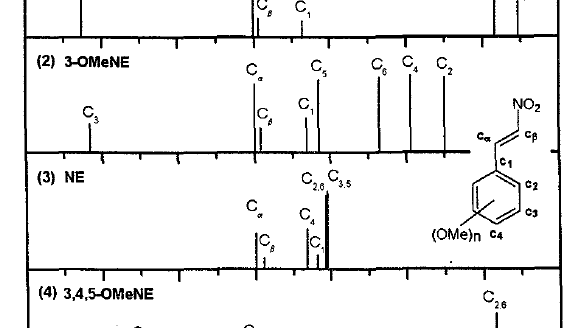
Morales, Raul G. E.; Araneda, Carmen; Jara, Gregorlo P.; Leiva, Manuel A.
13C-NMR Spectroscopy of β-Nitrostyrenes. II. Mono-, Bi- and Tri-Methoxy Phenyl-Substitutions and Long Distance Electronic Effects Journal Article
In: Spectroscopy Letters, vol. 33, no. 3, pp. 337-345, 2000, ISSN: 0038-7010, 1532-2289.
Abstract | Links | BibTeX | Dimensions | Tags: 2000, long distance electronic effects, Molecular orbital calculations, poly-methoxy-β-nitrostyrenes 13C-NMR spectroscopy
@article{RN43,
title = {13C-NMR Spectroscopy of β-Nitrostyrenes. II. Mono-, Bi- and Tri-Methoxy Phenyl-Substitutions and Long Distance Electronic Effects},
author = {Raul G. E. Morales and Carmen Araneda and Gregorlo P. Jara and Manuel A. Leiva},
url = {http://www.tandfonline.com/doi/abs/10.1080/00387010009350080
https://www.tandfonline.com/doi/pdf/10.1080/00387010009350080},
doi = {10.1080/00387010009350080},
issn = {0038-7010, 1532-2289},
year = {2000},
date = {2000-01-01},
urldate = {2000-01-01},
journal = {Spectroscopy Letters},
volume = {33},
number = {3},
pages = {337-345},
abstract = {By means of 13C-NMR spectroscopy and AM1 molecular orbital calculations of mono-, bi- and tri-methoxy-β-nitrostyrenes at the meta and para positions, we have characterized a long distance electronic charge transfer pattern on the ethylenic bridge (CH=CH) and on the aromatic ring (Ph) carbon centers, determined by the electron-donor nature of the methoxy-substituent groups. After a complete spectral assignment of the 13C-NMR signals, we have found a functional dependence of the chemical shifts on the C1 and Cβ centers respect to the C4 and C3 methoxy subtitution sites on the aromatic ring, while in the same molecular series Calfa-chemical shifts are practically constants. on the other hand, the 13C-NMR chemical shifts of the C3 and C4 centers plus the analysis of the AM1 electronic charge density have permitted us determine the long distance charge transfer effect induced by the C4 methoxy substitutions as well as the attenuation of this effect due to the C3 methoxy substitutions.},
keywords = {2000, long distance electronic effects, Molecular orbital calculations, poly-methoxy-β-nitrostyrenes 13C-NMR spectroscopy},
pubstate = {published},
tppubtype = {article}
}
1999
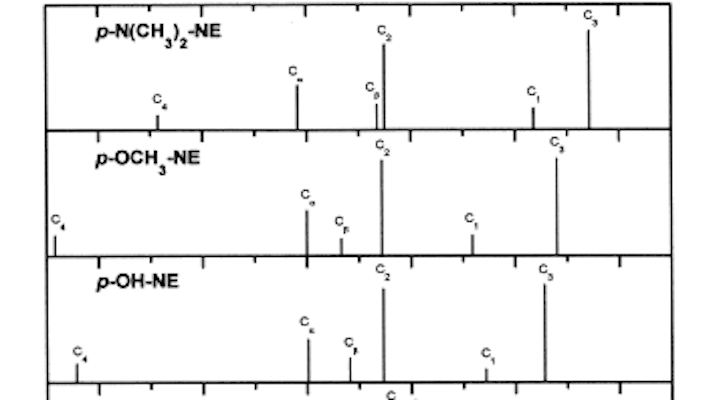
Morales, Raul G. E.; Leiva, Manuel A.
Long distance electronic effects of para-substituted β-nitrostyrenes by 13C-NMR spectroscopy Journal Article
In: Spectrochimica Acta Part A: Molecular and Biomolecular Spectroscopy, vol. 55, no. 7-8, pp. 1439-1443, 1999, ISSN: 13861425.
Abstract | Links | BibTeX | Dimensions | Tags: 13C-NMR spectroscopy, 1999, long distance electronic effects, Molecular orbital calculations, para-β-nitrostyrenes
@article{RN44,
title = {Long distance electronic effects of para-substituted β-nitrostyrenes by 13C-NMR spectroscopy},
author = {Raul G. E. Morales and Manuel A. Leiva},
url = {https://linkinghub.elsevier.com/retrieve/pii/S1386142598003205},
doi = {10.1016/S1386-1425(98)00320-5},
issn = {13861425},
year = {1999},
date = {1999-01-01},
urldate = {1999-01-01},
journal = {Spectrochimica Acta Part A: Molecular and Biomolecular Spectroscopy},
volume = {55},
number = {7-8},
pages = {1439-1443},
abstract = {By means of 13C-NMR spectroscopy and AM1 molecular orbital calculations of para-β-nitrostyrenes, we have found a characteristic long distance charge transfer pattern, where the olefinic bridge (CHCH) and the aromatic ring (Ph) carbon centres are perturbed according to the donor-nature of the para-substituent groups. After a complete spectral assignment of the 13C-NMR signals, the chemical shifts (δ) of the C1, C3 and Cβ centres show a linear functional dependence with the charge densities (qAM1), while in the same molecular series C2 and Cα are practically constants. On the other hand, an analysis of the electron-donor substituent effect at the para-position of the aromatic carbonyl compounds on the C4 centre, has permitted us to find a good correlation between the C4 chemical shift and the electronegativity of this vicinal centre.},
keywords = {13C-NMR spectroscopy, 1999, long distance electronic effects, Molecular orbital calculations, para-β-nitrostyrenes},
pubstate = {published},
tppubtype = {article}
}

